ACKNOWLEDGEMENTS
Particular thanks are due to the Dorset History Centre and to the Dorset County Museum, both in Dorchester, for their help in identifying documents of relevance to the family history back to Gideon Wright (1821 - 1900). Ancestry (at www.ancestry.co.uk) has been a particularly useful vehicle for pulling together the family tree at Appendix I that is described in this document. Thanks are due, too, to my cousin Liz Carter, to Janet Kennewell at the United Church, South Street, Dorchester, to Patrick Cooke at Athelhampton House, and to the Dorset Echo for their help in providing some of the photographs that are used to illustrate the text. Information has also been taken from a number of excellent Dorset village websites, including those for Piddlehinton, Maiden Newton and Bere Regis. The Ministry of Defence, Army Records, provided the information that underpins the period from 1940 - 1946, including the original of Douggie's Record of Service book (Army Book 439). Some details of the earlier generation of Wrights and Riggses is taken from a book "Their Excellencies" written by Canon William Joseph Wright, MA, MBE (one of Douggie's uncles) published in 1954. Aberystwyth University Library very helpfully provided access to a review of that book that was published in The Library and Book World in 1955.
Many thanks, too, are due to my wife, Jane, who has put up with me going off to work on "my project" for several months, without complaint.
INDEX
Acknowledgements
1. Introduction: and some reflections
2. Pre-history: Wrights of Dorset
3. Early life:
4. The Second World War (1939 - 1945)
5. The Firm
6. The Wrights in Dorchester
7. Family Life (1944 - 1973)
8. Family life (1974 - 2001)
APPENDICES
I. The Wright family tree
II. The family's involvement in Methodism in Dorset
III. Gideon Denner Wright and his offspring
IV. William Joseph Wright (1881 - 1954)
V. Main terms of an agreement between Gideon Denner Wright and his son Robert Smith Wright dated 28 October 1896
VI. Containerisation at Wrights of Dorset, 1960s
VII. Address given at Douggie's memorial service on 8 December 2001
DOUGLAS NORMAN WRIGHT
An Ordinary History
1. INTRODUCTION AND REFLECTIONS:
Douglas Norman Wright - known to everyone throughout his life as Douggie - was born on 29 May 1916, in Dorchester, Dorset. He was the second son of a modestly prosperous businessman, Robert Smith Wright, who ran a locally successful Provision Merchants with grocers shops in Dorchester and Weymouth.
Like 99% of us, Douggie had very little impact beyond the reach of his immediate environment, and he achieved nothing of major significance. This history is written, with a view to its completion before the 100th anniversary of his birth, simply to capture as far as possible where he came from and what he did. It tries to make use of the small amount of historical material that he left amongst his papers, mostly photographs, supplemented by information that it has been possible to glean from research online, in Dorchester and from other people. It also seeks to capture and set down relevant things that I remember being told as I grew up, while recognising that the validity of this information is susceptible both to exaggeration and/or refinement in the original telling, and to potentially highly inaccurate recall on my own part.
It is intended merely as a record for that very small number of people, mostly family, for whom it might one day be of some interest.
This history weaves together a number of different strands. There is the story of the Wright family's involvement in the 19th Century in promoting Methodism in Dorset (1). There is the story of the firm, G Wright and Son. There is the story of the very different experiences of different generations over the last 200 years. My researching of these stories, which has been fascinating in itself, has led me to reflect on a number of hugely significant changes that have occurred over this period. There is nothing very novel here; but it is interesting to recongise the way in which those changes have affected, and been effected by, our family.
First, Methodism. Douggie's great grandfathers, Gideon Wright and Levi Riggs, were both leading lights in the Methodist church in Dorset (also known as the Primitive Methodist church and/or the Wesleyan Methodist church) throughout much of the 19th Century. Douggie's grandfather Gideon Denner Wright, who was Gideon's son and Levi Riggs's son-in-law, took up this mantle with vigour and played an important role in helping to build local chapels in several villages around Dorchester.
We should not forget that Methodists were pretty unpopular at the time. They were at odds with both the Catholic Church and with the Church of England. They had their origins very much in the Parliamentarian, puritan tradition of Oliver Cromwell. So, for example, they had no truck with the rituals and such things as the intercession of saints that are so central to the Roman Catholic faith. They also believed that anyone could preach the Gospel and lead services. It was not something that was reserved to those who had been specially qualified by church authorities to be ordained into a priesthood.
And their insistence on temperance (ie abstinence from alcohol) also strongly limited their popularity with many ordinary people!
So to be a nonconformist, or dissident, at the time when Gideon, Levi and Gideon Denner were promoting their faith was not an easy option.
The end of the 19th Century was, it appears, something of a high point in the life of Methodism in England. It does not appear that Robert (Gideon Denner's eldest son, and Douggie's father) was particularly active in any religion. His generation (1870 - 1936) was, perhaps, the last one to feel obliged to profess a faith. It is interesting in this connection to note that most if not all of the chapels that Gideon, Levi and Gideon Denner were involved with are now private houses (Ansty, Cheselbourne, Piddletrenthide, Maiden Newton, etc) or shops (Buckland Newton) or have been demolished (Dorchester). Methodism, alongside Christianity more generally, has fallen pretty much out of fashion.
Next, the business. Gideon was clearly a very effective businessman. The son of a labourer, he pulled himself up by his bootstraps (no pun intended) to go from being a travelling shoesmith at the age of 20 in 1841 to owning his own substantial grocery and pork butchery by his early 50s. He handed on a thriving business to his son, Gideon Denner. Gideon Denner in turn brought his eldest son, Robert, and his youngest son, Denner, into partnership in the business. Douggie joined the business on leaving school, and his elder brother Robert (Robin) joined the business after the Second World War. There was, however, never any thought that I or my sister or cousins would go into the business and we were given no encouragement to think that we might do so. That may have been for any number of reasons. But it is a fact that, by the time I had reached an age at which I would have been looking for work, the Wright family business in any case no longer existed.
It is perhaps indicative of the way that commerce changed during the 1960s/70s that Douggie and Robin merged G Wright and Son with another business on the Isle of Wight, took the combined business to the London Stock Exchange, and then shortly afterwards sold their interests in it. That was probably a wise thing to do. And the period saw the closure of a large number of local Dorchester businesses, including Tilleys (cars and bicycles), Parsons (tea and coffee merchants), Ricardos (builders), and Lott and Walne (foundry). In practice, few if any of these businesses were generating enough income to support the engagement of another generation of the family. Consolidations and takeovers were very much the order of the day. Eldridge Pope's brewery business lasted longer than most, but still succumbed finally in 2010. A few other small local businesses such as Goulds department store, Lings (printers) and the professional accountancy firm of Edwards and Keeping (though in the last case now with no active family members) still survive, but they are the exception, rather than the rule. Douggie and Robin's generation was the one that saw the near-extinction of the family business as such, and its replacement with the here-today-hopefully-bought-out-very-profitably-tomorrow culture of the Thatcherite entrepreneurial start up.
Third, generational expectations:
-
Robert's generation went through the First World War. Douggie and Robin's generation went through the Second World War. My generation and my children's generation have been remarkably fortunate in being the first ever not to have known or been involved in active conflict of one kind or another. So far.
In Robert's generation, and in those before him, most people went to work as soon as they were physically capable of doing so. Robin and Douggie's generation went to work after a relatively rounded and extensive education up to at least the age of 15, leaving at the School Certificate stage. I was only the second Wright (after Douggie's uncle William Joseph) to go to university, and even then alone amongst my generation in being lucky enough to do so - as much, I suspect, because I was the only boy as because of anything to do with ability or aptitude. My children, and my cousins' children, all went to university. The family lived for over two centuries and for four generations in Dorset, in Dorchester or Piddletrenthide. They worked in Dorchester. My generation started to move away, although the fact that Douggie and Robin stayed put meant that we all had connections back to the county. As it happens, my cousins and I have all come back to Dorset (or very close thereto) in our retirement. For my own part, I can only say that I feel a very strong connection to the county, and I am very happy to be back in Dorset after spending most of my life away. I feel strangely that I belong here. The next generation, however, will feel very different loyalties, and will likely have very little to connect them to the county of their forefathers.
It is also interesting to reflect on the nature of the main characters in this story.
-
Gideon initiated the family business. A staunch Methodist, he played a significant role in developing the Methodist church in North Dorset. By the time of his death in 1900, he was a wealthy man, and something of a pillar of the community.
Gideon Denner played, if anything, an even more significant role in the Methodist church, alongside his father-in-law, Levi Riggs. He is directly connected with the building of more than half a dozen chapels in Dorchester and in villages as far flung as Piddletrenthide, Maiden Newton, Cheselbourne and Bere Regis. This is no mean feat when one remembers that, at the time, travel between these places was on foot, on horseback or by horse-drawn carriage. At the same time, he ran and developed a highly prosperous business. And he still found the opportunity to father 14 children!
Robert is much more difficult to pin down. He lived at home with his parents until he was 40, working under his father in the family business. He then married someone who by the standards of the time would have been regarded as being very much beneath him - although she gave the impression at least later in life that she'd been born from the outset used to a life of upper middle class comfort. Did he have to stand up to his father over this? Or were Gideon Denner and Susanna quietly relieved that at last he'd moved out?
Robert became one of about a dozen Borough Magistrates sometime in his 50s, in which role he was a colleague of Thomas Hardy OM. Robert was still a Justice of the Peace in 1931. But apart from these few thin facts that it is possible to trace at this distance , he seems to have slipped through life without much touching the sides, leaving very little by way of a trace. There is no evidence, either actual or anecdotal, of his having actively promoted Methodism to his own children (although Douggie's brother Robin became a mainstay of the Church of England in Piddletrenthide). There is no sign that he did much if anything to grow or develop the business, leaving a shop and yard in High East Street much as he'd inherited it from his father, 15 years earlier - albeit that his estate was twice the value of his father's.
Of Douggie we of course know a good deal more, primarily because we have firsthand accounts of what he did. He seems to have enjoyed his business life - one gets the sense that innovating things, in particular, was fun for him - and it seems to have given him a decent standard of living, even if he never managed to make much money out of it. He was ahead of his time in not retiring until he was well into his 70s. After his retirement he left Dorchester and moved to Marnhull, where he threw himself enthusiastically and generously into supporting local charitable efforts.
One thing in particular that strikes me as a result of this research is that the family business came full circle in just four generations. From nothing, to relative prosperity, to nothing again. That's no-one's fault as such; it's merely a consequence of history and circumstance. But it's an interesting fact.
Notes:-
(1) Much of the most interesting historical material, both about family members and about their role in promoting Methodism in Dorset, is in the Appendices to the main text2. PRE-HISTORY: WRIGHTS OF DORSET [Link to more information about Gideon Wright's father John Wright (1785-1861) on the OPC website]
The core family tree for the Wrights is at Appendix I. Douggie's great grandfather, Gideon Wright, was born in 1821, the son of a labourer, John Wright and his wife Elizabeth . There appears also to have been a daughter, Ellen, born in around 1826, who appears in the 1841 Census. But it is not clear whether she survived into adulthood, or if she did, what happened to her.
In 1841, at the age of 20, Gideon was a journeyman shoemaker, living with his parents in Back South Street, Dorchester. He would have earned his living travelling around the town and the local area mending and making shoes. Yet he clearly managed to improve himself. By 1852 he was listed in Slater's Directory for the town under the heading of "Shopkeepers and Dealers in Groceries and Sundries" and by the 1861 Census he was able to describe himself as a Master Grocer.
Gideon's wife Elizabeth was 8 or 9 years older than him. On 11 December 1844, Elizabeth gave birth in Dorchester to Douggie's grandfather, Gideon Denner Wright (2). She survived to the age of around 65, dying in 1886. At the age of 68, Gideon remarried. Mary Battiscombe was a lace cleaner from London aged 63. They lived together for 11 years until Gideon died at the age of 79 in 1900. Mary died in 1913 at the age of 87.
Gideon Denner, as the first (and, as it turned out, the only) son, would have started in the family business from about the age of 14, ie in around 1858, or possibly earlier (there being no compulsory school leaving age until the Elementary Education Act of 1880 first introduced one). This is consistent with his description in the 1861 Census, when Gideon Denner then aged 17 was living at home with his parents at 17-18 Grove Buildings in Dorchester, and his occupation was given as a Grocer's Assistant. Eight years later, on 15 July 1869 at the age of 25, he married Susanna Riggs at Cheselbourne Church. Born in Dewlish, Dorset on 29 April 1846, she was a couple of years younger than him.
Susanna's father (Douggie's great grandfather), Levi Riggs, was a successful farmer. In 1871 he was employing 8 men and 4 boys at his farm in Cheselbourne. From 1885 to 1922 he and his son Joseph Adams Riggs also tenanted Manor Farm at Piddlehinton (3). William Wright (one of Douggie's uncles), writing in about 1951 in his book "Their Excellencies" (4), described him thus:
"My grandfather was a Dorset farmer, very hard working, and to the modern mind he may seem to have lived a very narrow life. Nevertheless, he lived intensively, and he achieved tasks and purposes which today seem remarkable. He would ride 50 miles to Bristol in order to attend the Methodist Synod, and he saw nothing incongruous in acting as a churchwarden and attending service at the parish church. His life was as straight as the shortest distance between two points and the word "compromise" was one which he could never act upon."
Levi Riggs was also a leading member of the Wesleyan branch of the Methodist Church, alongside Gideon and Gideon Denner. In the 1871 Census, Gideon Denner is described as being a grocer and provision merchant and a "Methodist Local Preacher". Levi, Gideon Denner and Gideon are named amongst the trustees of a number of Methodist Churches in Dorset including at various times Dorchester, Tolpuddle and Maiden Newton, in each of which they had played a part in acquiring the relevant land and building of Wesleyan churches on it. Further details of their leading involvement in the Methodist Church in Dorset is at Appendix II. Levi Riggs died on 4 October 1886.
-
Side Note: One of Levi's sons, also called Levi, farmed most of his life in Piddlehinton and became a noted breeder of Jersey cattle. He was killed in 1918 when his coat caught in some farm machinery (5)
On 14 October 1870, Susanna gave birth to Robert Smith Wright, Douggie's father, at their house at Grove Cottage, Millers Close, Dorchester.
Robert was the first of 14 children - eight boys and six girls - to whom Susanna gave birth over the next 20 years, 12 of whom survived childhood. Surprisingly, notwithstanding the strain this must have placed on her, Susanna survived until 12 December 1931 when she died at the age of 85. As was usual at the time, the older children (particularly daughters) would have taken over much of the care of the younger ones. There is a story that on one occasion, Alfred Denner (their youngest son, known as Denner, born in 1890) took his mother the morning paper to read. As she thanked him she added the comment "And who's little boy are you, then?".
Individual pictures of Robert, his father and his grandfather, taken from a group photo in the late 1890s of the directors and staff of G Wright and Son (shown in the section on The Firm, below) are below.
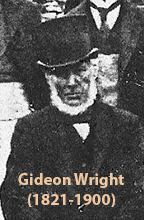
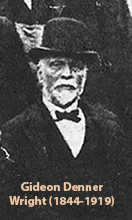
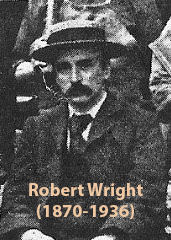
William Wright was the third of the eight boys, born 11 years after Douggie's father, Robert. William's book talks of his childhood at home in the following terms:
"My father, christened Gideon, lived up to his name and he was eloquent in both words and deeds. He had twelve (6) children, and the task of providing for such a large family did not prevent him from driving eight, ten and even fifteen miles on a Sunday to preach in some country church.
"My mother was that miracle of love and sacrifice to be found in so many Christian homes. The sacrifices involved in caring for her large family were taken as a matter of course, and there can be no doubt that her patience and lasing affection had their inspiration in her faith which was always equal to every situation, no matter how trying it happened to be.
"Family prayers were held morning and evening, and Sunday always ended with Jackson's Te Deum, one of my sisters playing the organ and another the piano. As a boy, I felt that this was rather too much and I feared that the sound of the singing would penetrate to the nearby school which we attended, and, in fact, this frequently happened."
Pictures of Robert, taken when he was around 20 and around 30 are shown below.
.jpg)
.jpg)
Robert probably left school and joined the family business in his early-teens. As discussed in more detail later, at the age of 26 in October 1896 he was taken into a formal legal partnership with his father, Gideon Denner. On 11 August 1910, while still living with his parents over the shop in High East Street, Dorchester, Robert married Elsie Gertrude Ireland at Broadstone Church near Poole. Robert was 40, quite old for a first marriage, and a relatively prosperous businessman. Elsie was 20, by all accounts a beauty, and was the daughter of a gardener and a laundress, with some acknowledged Romany blood on at least her mother's side if not both sides of the family. It was hardly a marriage of equals; but it was doubtless one that suited both very well. Robert and Elsie's first son Robert Riggs Wright (known throughout his life as Robin) was born on 27 August 1912. Then in 1916, on 29 May, Elsie gave birth to their second son Douglas Norman Wright (Douggie).
Notes:-
(2) referred to throughout this document as Gideon Denner, to distinguish him from his father Gideon(3) The Story of Piddlehinton, Dorset Books, 1990, p 11.
(4) pub E Backus, Leicester, 1954
(5) from documents held at Dewlish Mill, with acknowledgement to Mandy and David Hawkins.See also an article in the Western Gazette of Friday 5 July 1918. It is also recorded that one George Bollen, who was 92 in 1970 and had been custodian of the Methodist Chapel, confirmed this story.
(6) In fact 14. We know that one boy, George Levi, died young; and presumably one other, probably the third daughter, Margaret.
(7) Currently in the possession of Rob Wright
At the time of Douggie's birth, Robert and Elsie were living at a house ("Elsinore") at Number 1, Dagmar Road, Dorchester. Robert was at this time running the family business and was a minor local dignitary, having inter alia become a Borough Magistrate of the town Corporation by 1915, alongside other local figures including the author Thomas Hardy OM (8).
Not much is recorded about Douggie's early life. There are just two blurred baby photos (below), neither of them very flattering.
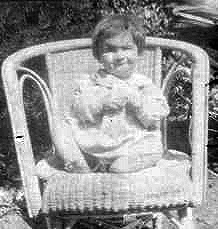
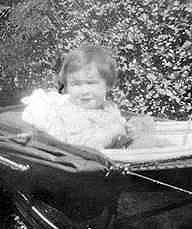
It was expected that the children of such a relatively prosperous business family would be educated privately. Nothing is known of where Robin or Douggie went initially to school. But by the time they were in their teens, Robin was boarding at Blundells School in Tiverton, Devon. Douggie was at Dorchester Grammar School from 1925 - 1928 and then at Weymouth College (later to become Weymouth Grammar School) from 1928 - 1932. He passed his School Certificate (the equivalent of GCSEs) in 1931.
Douggie had been born with extropia, a reverse (ie outward looking) squint also known as a divergent strabismus, which meant that he was unable to bring his eyes to converge properly on a point. [Interestingly, close examination of the original photographs of his father on previous pages suggests that he may have suffered from the same condition.] Douggie had at least one operation as a child on the muscles around his eyes to try to correct this problem, but it was unsuccessful. As a result, throughout his life, he had double vision of anything in the centre of his field of view. He compensated for this to some extent by mentally blocking the image from one eye or the other, but this gave him only monocular vision (ie with no sense of perspective). It was very tiring and it meant that, for example, he was never able to play ball games (as he couldn't judge how fast things were approaching him). This must have made him something of an outsider amongst his contemporaries at school.
There are only a few photographs from Douggie's later childhood. In the first, where he appears to be around 8 or 9 years old (ie in around 1925), he is with his brother Robin. In the last two, he is pictured with his parents (Robert and Elsie) and Robin. The final picture in this group shows Douggie's mother Elsie from around the same time.
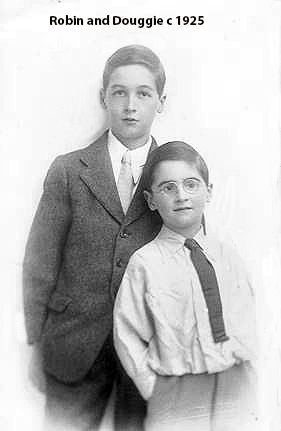
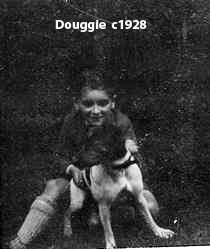
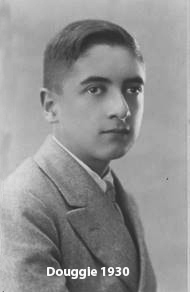
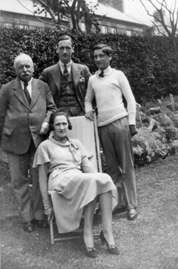
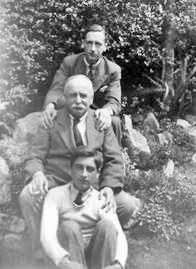
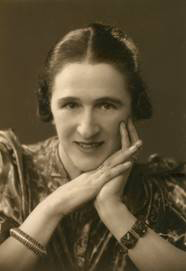
Elsie ca. 1932
Robert died on 6 April 1936 in Yeovil Hospital. The story passed down is that he had a heart attack when he was involved in a road accident while passenger in a car that Douggie was driving. If that is so, it must have been a great personal shock for Douggie who was well known to have been particularly fond of his father.
Notes:-
(8) Kelly's Directory, 19154. THE SECOND WORLD WAR (1939-1945)
Douggie enlisted in the Royal Artillery at Exeter as a Gunner (ie Private) on 18 July 1940. He was transferred to the Pembroke Heavy Regiment in Milford Haven on 15 August and then to the Coastal Artillery School at Llandudno on 24 November. In the meantime, he applied for a Commission.
On 19 September 1940, he was interviewed by a Board chaired by a Major H C Gould. The Board report described his Military Character as "very good". His Power of Leadership was said to be "Average - but with experience he should attain a higher standard". And the overall assessment said that he was "A quiet mannered boy [comment: aged 24!] who with an Officer Training Course behind him should make an officer well up to the average".
Following this not entirely glowing assessment, he was posted as an Officer Cadet to the Officer Cadet Training Unit in Plymouth on 27 September 1940, and on graduating from the course on 20 December 1940, his Commanding Officer Major G Barnett signed his release from the ranks for the purpose of being appointed to a Commission. The paperwork says that his Military Conduct had been "Very Good during his 6 months service". It noted that he had "Qualified by his conduct to have received an award of Exemplary for military conduct", but that he was "ineligible [for an Exemplary marking] because he has not completed 2 years service". The notes went on to describe him as:
"Hardworking, reliable and honest. Can be thoroughly recommended for a position of trust. Well educated, intelligent and self-reliant".
On Christmas Eve in 1940 he was posted back to Llandudno as a newly appointed 2nd Lieutenant, and then on to Coastal Artillery Sections in Newhaven and Brighton and the Searchlight Section at Worthing. A photograph from about this time, as a 2nd Lieut, is shown below. It is more than likely that it was in this period that he first met Nora Hatton-Jones, who lived in and around Bognor Regis, and whom he was to marry in 1944.
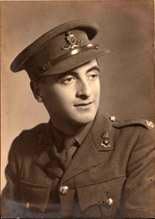 In early November 1941, he was posted to the RA Depot at Woolwich in London. Then, on 2 December 1941, he embarked for Gibraltar. He told the story that he had embarked from Gibraltar to go to Singapore but that, when Singapore fell on 15 February 1942, his ship returned to Gibraltar where in the end he was to spend much of the rest of the war lobbing shells onto German positions in North Africa.
In early November 1941, he was posted to the RA Depot at Woolwich in London. Then, on 2 December 1941, he embarked for Gibraltar. He told the story that he had embarked from Gibraltar to go to Singapore but that, when Singapore fell on 15 February 1942, his ship returned to Gibraltar where in the end he was to spend much of the rest of the war lobbing shells onto German positions in North Africa.
On 21 June 1942 he was promoted to Lieutenant. He became an Acting Captain on 1 December 1942 and a Temporary Captain on 1 March 1943. While still in the substantive rank of Lieutenant, he was appointed an Acting Major with effect from 10 February 1944.
The photograph below shows his battery on Gibraltar in 1943, with Douggie seated centre.
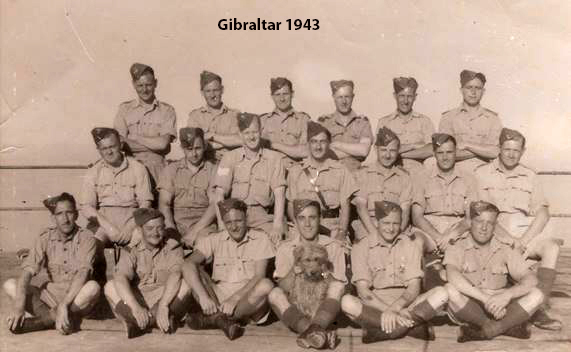
Amongst his papers were some documents relating to this period. Photos from these documents are shown below. One, dated 4 July 1942, acted as an Identity Card for travel from Gibraltar into Spain. Others, dated 20 and 22 April 1943, relate to a visit Douggie was to make on government business from Gibraltar to Tangiers. It is presumably from this visit to Tangiers that the story arose of a particularly lucky escape. Douggie had been met by a car on his disembarkation from the ship in the harbour in Tangiers. He told the driver that he wanted to stretch his legs, and would walk to the end of the pier where the driver could pick him up. As it drove down the pier, the car exploded either from a bomb or from being hit by a shell, and the driver was killed outright. Douggie survived without a scratch.
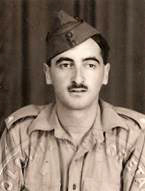
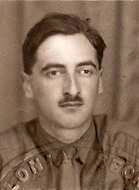
Douggie: July 1942 Douggie: April 1943
All his time in Gibraltar, Douggie had been trying to secure a transfer from the Royal Artillery to the Infantry, specifically to the Dorsetshire Regiment. He eventually managed to achieve this in early 1944. On 18 March 1944, he arrived back in the UK and, after 3 weeks disembarkation leave, he went back to Woolwich. By this time he was a Lieutenant again, having had to relinquish his more senior acting and temporary ranks on leaving Gibraltar. He was admitted to the Royal Masonic Hospital for an unspecified reason on 25 April 1944 but was out again and posted to 522 Coastal Regiment on Portland by 10 May 1944. In October 1944 he got married and was granted 10 days leave before returning to Portland. He then went on an infantry conversion course in Dunbar from 28 November 1944 to 26 January 1945. And then on 28 January 1945, he finally achieved his ambition to transfer to the Dorsets.
Nothing is known of what he got up to most of that year. The Germans surrendered in the first week of May. But on 21 November 1945, he embarked at Dover with the 1st Battalion Dorsetshire Regiment to join the British Army on the Rhine. He was posted with the First Battalion, Dorsets, first to Oerrel near Hamburg to join in the clearing up after the war, and then in March 1946 to Berlin. He never really talked about this time, except to say how devastated the infrastructure was in Berlin, to the extent that it was cheaper to brush ones teeth in champagne than in water. On 5 May 1946 he joined the 5th Battalion Dorsets, prior to being demobbed on 28 May 1946, which was almost certainly coincidentally the day before his thirtieth birthday. His record book shows that he was authorised by his commanding officer at Aldershot the day after to exhange 640 Deutschmarks for sterling, the final sign off of his engagement in the Army.
That said, Douggie's Record of Service book (AB439) has a note scribbled in pencil inside the back cover. This says: "20th September [no year], Dorset Dinner, Dorchester Hotel, Too drunk to know". It is signed by a Bill Ridley. Hmmm ....
The first description of Gideon Wright (the original "G" of G Wright and Son) as a grocer is to be found in Slater's Directory for 1852, where he is listed under the heading " Shopkeepers and Dealers in Groceries and Sundries". By the 1861 census, he was describing himself as a Master Grocer, with premises at 17-18 Grove Buildings, West Fordington. Fordington at the time was a parish which extended in a crescent from the military barracks at Poundbury to the West of the town all the way around to the area around St George's Church, the parish church, to the East of the town. Grove Buildings no longer exist, although the name carries on in The Grove which constitutes part of the main road out of town to the North from the Top o' Town. In 1861, Gideon Denner, aged 17, was living with his parents at Grove Buildings and was described as a Grocer's Assistant.
By the 1871 Census, Gideon had expanded the business and was living in 17-19 Grove Buildings. He is listed as a Grocer and Provision Merchant employing 3 hands. Gideon Denner, newly married, had moved round the corner to Grove Cottage at 1 Miller's Close. Miller's Close still exists as a road but is now part of a large industrial estate at the bottom of the Grove. Gideon Denner was also by now described as a Grocer and Provision Merchant.
On 11 October 1873, Gideon entered into a contract (9) with Thomas Bennett whereby G Wright and Son (the first time the name appears as such) would buy Bennett's business - described as consisting of "several trades or businesses of a Grocer, Provision Merchant and Pork Butcher" - at number 19 High East Street, Dorchester. [The photograph below shows a copy of an earlier account sent by Thomas Bennett to the Antelope Hotel, dated Xmas 1865 (10).] The purchase of the business included all "stock in trade, utensils, implements, articles and materials and effects of every kind", which Gideon bought for the sum of £940 (equivalent to about £96,000 at 2016 prices). By the same agreement, Gideon also undertook to rent the property, which included the shop at 19 High East Street together with stables and other buildings in Bell Street (now Icen Way), for 21 years at a rent of £100 a year.
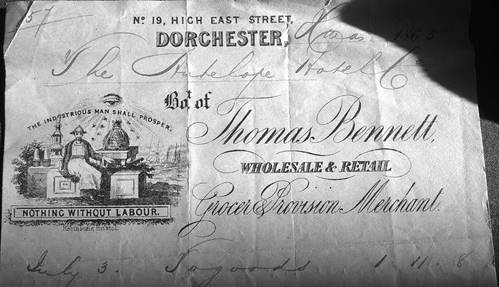
As a result of this agreement, the 1881 Census shows Gideon and Ellen for the first time at 19 High East Street, Dorchester where they were living above the shop. By this time, Gideon was employing 12 men. Gideon Denner had moved to Trinity Street where he was living with his wife Susanna, seven children (including Robert, then aged 11), one of Susanna's sisters (Emily Jane Riggs, aged 32) and two servants.
In the course of the 1880s, Robert left school and joined the family business. The picture below shows the three generations of Wrights (L-R Gideon Denner, Gideon and Robert) with their staff. It must have been taken around 1890 - 1895. It is likely to have been taken in the stable yard behind 19 High East Street on what is now known as Icen Way. It shows the twelve men and a lad who were presumably employed by the firm at the time.
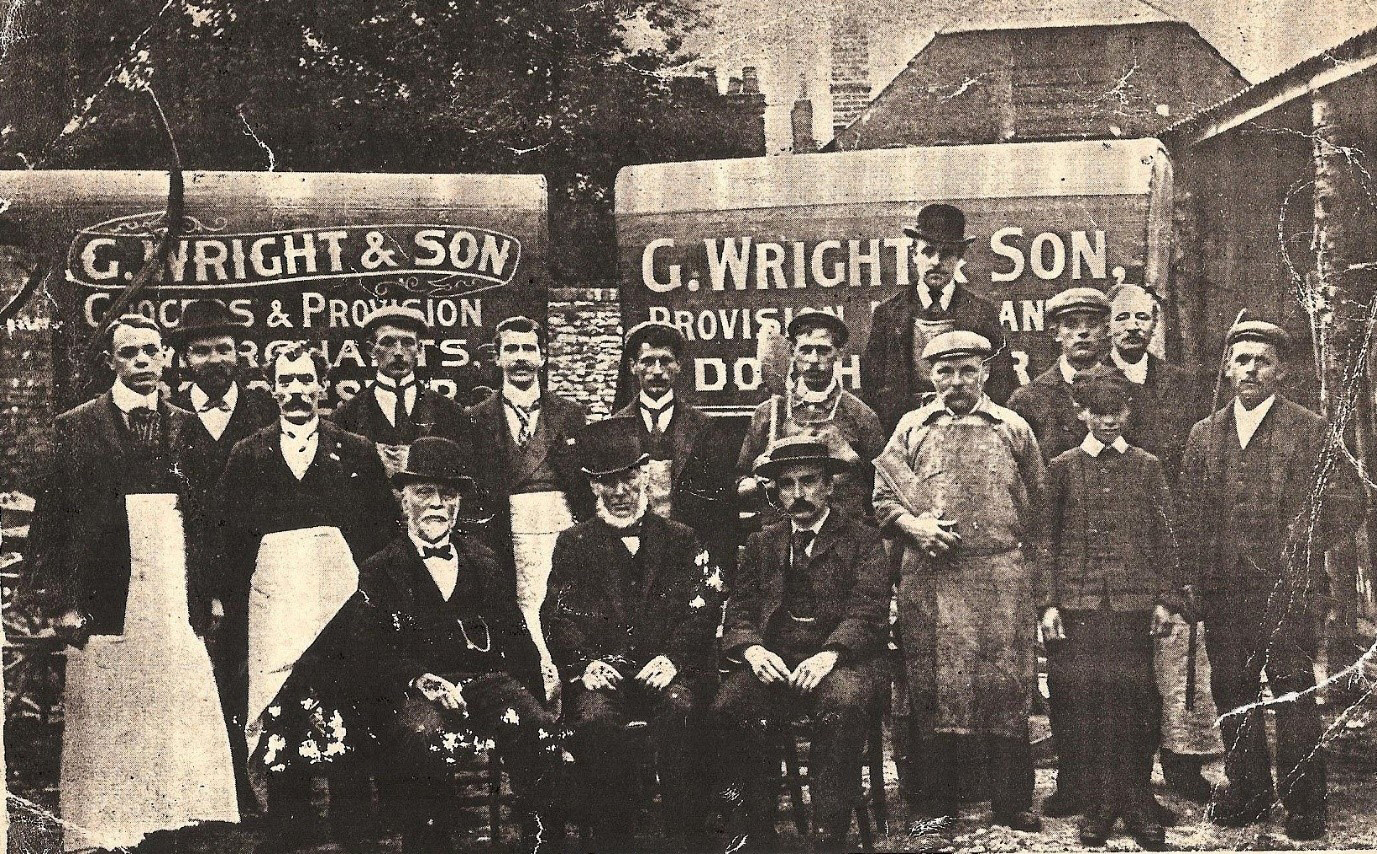
© Picture kind permission of Robert Wright
By 1889, Gideon - then aged 68 - was contemplating retirement. On 2 October 1889, he and Gideon Denner signed a formal agreement bringing Gideon's involvement in the business to an end. This noted that they had "for many years carried on business in Dorchester, Weymouth and Melcombe Regis" and that they had agreed "to end the co-partnership" in exchange for Gideon Denner agreeing to pay Gideon the sum of £100 a year for the rest of his life. The agreement went on to note that "in pursuit of the said arrangement and in consideration of the natural love and affection which the said Gideon Wright has for his son Gideon Denner Wright", Gideon assigned his whole share in the business to Gideon Denner. Explicitly excluded from the agreement, however, were a number of assets which Gideon continued to retain, including "his share of certain premises situate in West Walks, Dorchester; his share of Sydling Mills; a debt due from Ballam & Son on the security of their promissary note; a share in a certain policy on the life of J A Riggs(11); and his share in the Metropolitan Coal Company".
It is clear from this agreement that Gideon had been very successful. He had managed to rise from being an itinerant shoe mender in 1841, the son of a labourer, to being able to invest a considerable sum in buying out Bennett's business in 1873. And he had gone on from there to become the head of a thriving business and the holder of significant other assets by the end of the 1880s.
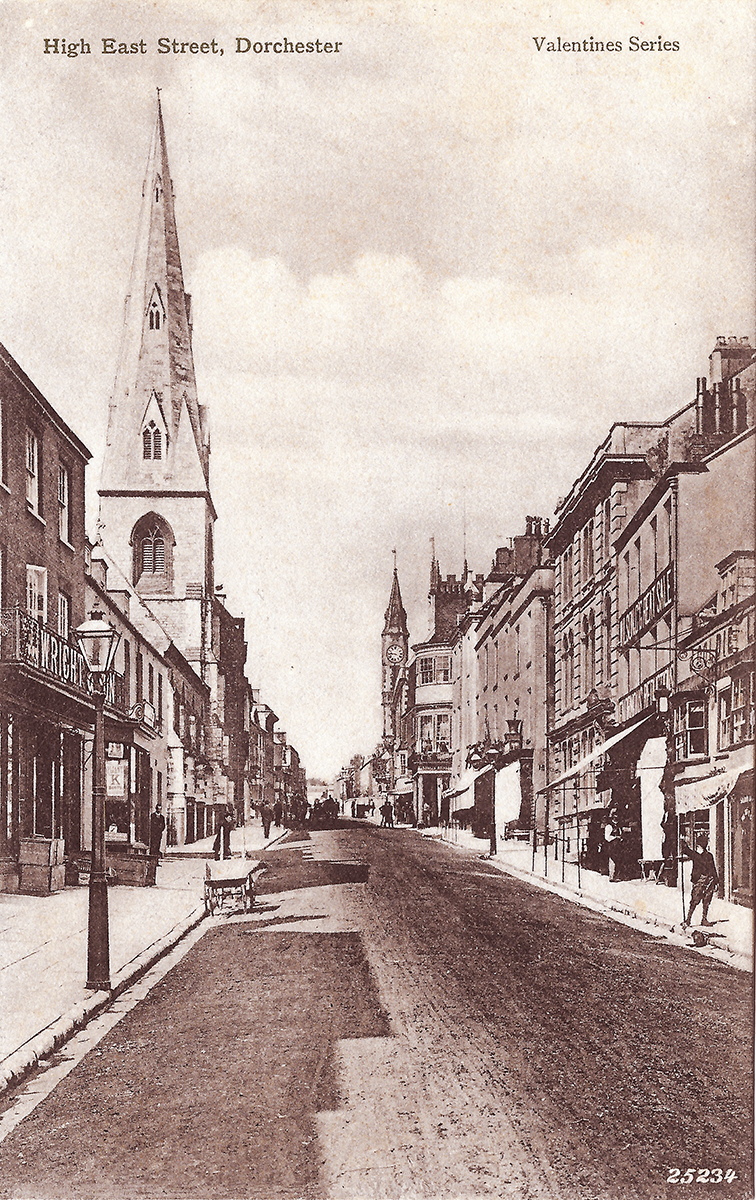 The 1891 Census and Gideon's death certificate show that he and Mary continued to live above the shop at 19 High East Street until his death in June 1900. Probate records show that he left an estate of £975 (equivalent to about £113,000 at 2016 prices), even after having made over his share of the firm to Gideon Denner.
The 1891 Census and Gideon's death certificate show that he and Mary continued to live above the shop at 19 High East Street until his death in June 1900. Probate records show that he left an estate of £975 (equivalent to about £113,000 at 2016 prices), even after having made over his share of the firm to Gideon Denner.
In a postcard of High East Street in Dorchester, left, from around 1895, the wording "Wright and Son" can be clearly seen on the wrought iron balcony of Number 19 in the foreground on the left of the picture behind the lamp post.
Another picture of High East Street, below, from a private collection of original negatives held at Athelhampton House reproduced with the kind permission of Patrick Cooke, shows the same section of the street at around the same time. The words "Wright and Son" can be seen clearly on the balcony on the building next door but one to the Phoenix Hotel in the original glass negative (you may however need to use the zoom facility on your browser on this reproduction).
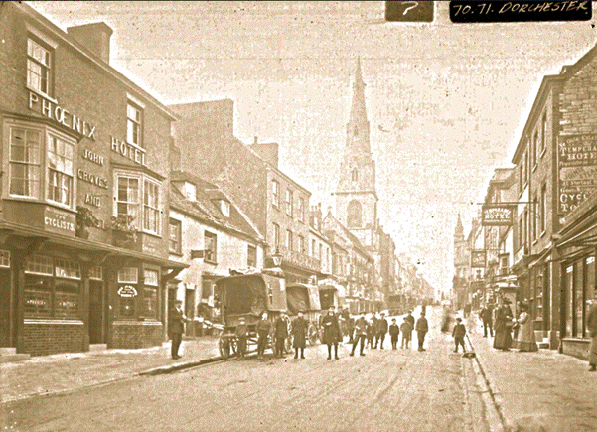
In 1896, Gideon Denner brought Robert formally into the partnership by means of a Partnership Agreement dated 28 October (12) , the main terms of which are at Appendix V. Electoral records from 1899 and 1903 show that, in addition to the shop and premises at 19 High East St in Dorchester, G Wright and Son (by that time Gideon Denner and Robert) were trading in Weymouth at 9 Market Street, on the corner with Maiden Street as "cheese factors". Later, probably in about 1905, Gideon Denner's youngest son, Alfred Denner - known throughout his life as Denner - also joined the business. There is no evidence of any other of Robert's brothers or sisters joining the firm.
Gideon Denner continued to run the firm throughout the 1914-18 war. He died on 27 January 1919, at the age of 74. Probate records show that he left an estate of £7,920/18s/11d - equivalent to about £405,000 at 2016 prices. This was a considerable improvement on his father's estate, although it would have included a part of the value of the ongoing business which Gideon's estate did not include.
Robert was too old to be involved in the 1914-18 war, being well into his forties when war was declared. Denner was not so lucky, however. He joined up in the Royal Fusiliers in 1915 as a Private. Despite twice being wounded in action and contracting malaria in Salonika (Greece), he survived the war (see details at Appendix III). He was demobbed in 1919, just four weeks after his father Gideon Denner had died. It is likely that he went straight back into the family business on his leaving the Forces, to work with Robert in running the business following their father's death.
The firm continued to branch out into new areas under Robert's and Denner's guidance. Kelly's Directory for Dorset in 1923 and in 1927, for example, describes G Wright and Son, still at 19 High East Street, as being "wholesale and retail grocers and provision merchants; home-cured bacon and Dorset dairy produce a speciality (eggs, butter, Dorset blue cheese, fresh pork &c)".
Not much is known about the development of the business from the 1930s through to the end of the Second World War. Douggie's brother Robin trained before the Second World War in accountancy, working in a bank. On leaving school, Douggie went into the business, probably in his mid-teens. Although there is no hard evidence, my understanding is that he was initially apprenticed to be a cheesemaker, probably with a firm in Southampton.
Robert died at the age of 66 in 1936, leaving an estate of £13,588/15/1d (worth around £807,000 at 2016 prices). He was still playing an active part in the business. Douggie was 20 and Robin was 24. At or around this point, the remaining Wrights took up individual roles within the business. Denner became Chairman, Robin Company Secretary, and Douggie Managing Director. Denner must have kept the business going during the Second World War, as both Robin and Douggie were in the Forces. But it was after the war in particular that the business continued to expand and extend its operations in Dorchester and beyond.
By the 1950s, the firm comprised a number of subsidiary businesses within the G Wright and Son "family". These included Wrights of Dorset Ltd, Eggdon Food Products, and Dorset Eggs. I recall from my childhood many of the Wrights of Dorset products: cylindrical packets of golden yellow butter, wrapped in waxed paper; cheddar cheese; hard Dorset blue cheese; bacon, both smoked and unsmoked; hams; sausages; and pork pies - both family sized round ones and larger rectangular ones with eggs running through the middle of them. One could easily have a picnic where all the food, apart from bread and a bit of salad, had been produced in one of the family businesses - and we often did. Perhaps strangely, it didn't strike us as at all odd that so much of what we ate came from packaging branded with our surname.
G Wright and Son focused primarily on the wholesale grocery, with Douggie taking much of the responsibility for growing this side of the business. Sometime after the war, the firm's operations became increasingly cramped in High East Street. So they moved to new custom built premises in St George's Road, Fordington, on land rented from the Duchy of Cornwall. Although the entrance to the site ran between two rows of terraced cottages and was only wide enough for a single lorry to go in or to go out, not both at the same time, the new premises were well suited to a medium scale wholesale grocery business. Manufacturers shipped their goods into the warehouse. G Wright and Son then sorted them into deliveries to local grocery shops, according to their needs.
On selling the shop in High East Street to Dorset County Stores, the firm stopped running its own grocery shops. Instead, it concentrated on developing relationships with independent stores over a wide area of Dorset into which it could sell and to which it could deliver a huge range of groceries. In the late 1950s, many of the stores took on SPAR branding, encouraged by the firm. The concept of branded independents, able to take advantage of the higher purchasing clout of a shared procurement platform, was novel in the UK at the time, although it had been shown to work well in Scandinavia and elsewhere.
Throughout the late 1940s and 1950s, the firm continued to grow. It became, alongside the Eldridge Pope brewery, one of the larger employers in the town. The photograph overleaf is taken from the Dorset Evening Echo of 1 March 2011. It had been sent in by a Molly Gerrard, who is pictured fifth from the right in the second row from the back. The picture was taken at G Wright and Son's Christmas 1950 party for staff and customer representatives, held in the Dorchester Corn Exchange building. Ms Gerrard had worked as a bakery assistant for 25 years in one of G Wright and Son's customer grocery stores, Grey's in Broadwey near Weymouth, and would have been given her invitation by her employer.
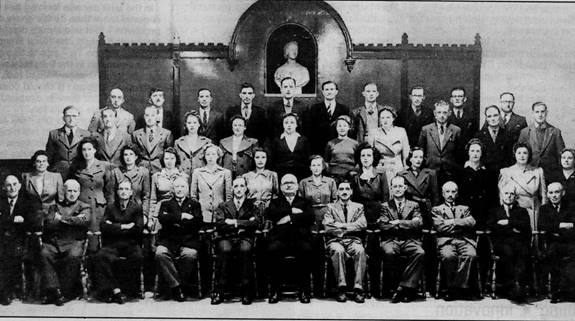
G Wright and Son's 1950 Christmas Party. Denner is seated centre, with Douggie
on his left and Robin on his right. [Dorset Evening Echo, 1 March 2011]
A collage taken from some G Wright and Son marketing material from the early 1950s is shown below. This shows a number of aspects of the business, including the taking of orders from shops, the baking of pies and pastries, invoicing, vehicle maintenance, the stacking of cheddar cheeses in the cheese room, and so on.

The above picture shows Robin (left) and Douggie wearing jackets in the picture towards the centre of the collage. Denner is the bald headed man on the right of the picture below that, seated at a table talking to one of the managers.
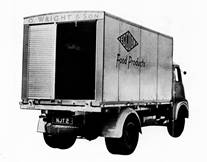 To be successful, the firm needed to concentrate on being as efficient (and as cost effective) as possible a logistics operation. This was Douggie's forte. Among many other innovations that he brought to the business was a new approach to the loading/unloading of lorries. He realised that much of the cost of the business was tied up in delivery vehicles which spent much of their time waiting to be loaded and/or unloaded at the warehouse or at the stores. He therefore set about working out a way in which the body of the lorry could be detached from the chassis, so that only the body would be involved in the time consuming task of loading and unloading.
To be successful, the firm needed to concentrate on being as efficient (and as cost effective) as possible a logistics operation. This was Douggie's forte. Among many other innovations that he brought to the business was a new approach to the loading/unloading of lorries. He realised that much of the cost of the business was tied up in delivery vehicles which spent much of their time waiting to be loaded and/or unloaded at the warehouse or at the stores. He therefore set about working out a way in which the body of the lorry could be detached from the chassis, so that only the body would be involved in the time consuming task of loading and unloading.
The idea took much of its shape on our kitchen table. Douggie had bought some Dinky Toy versions of the then ubiquitous Austin 7-ton lorry (see left). He carefully sawed off the bodies from the chassis and then worked out ways in which the truck could back up to a loading bay, someone could unlock and push the (empty) body off onto rollers and into the warehouse, a new (full) body could be pushed out of the warehouse and onto the chassis, and the lorry could drive off again on its next delivery round. This was the birth of containerisation.
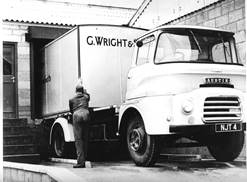 By 1959, with the help of an engineering firm Cargon Transport (GB) Ltd from Tipton, Staffordshire, the models had become a reality (see picture left). This produced a huge increase in productivity (see detail in Appendix VI). One of the consequences of this was that the lorry drivers no longer had to work overtime, and so no longer got overtime pay. Recognising the impact this would have on their families, Douggie arranged that they would be paid by the weight of goods they delivered, so that they could take home the same pay as before - and without having to work the overtime. This dissipated a chunk of the productivity gain, but Douggie's view was that small local businesses had to be good to the people who enabled them to grow.
By 1959, with the help of an engineering firm Cargon Transport (GB) Ltd from Tipton, Staffordshire, the models had become a reality (see picture left). This produced a huge increase in productivity (see detail in Appendix VI). One of the consequences of this was that the lorry drivers no longer had to work overtime, and so no longer got overtime pay. Recognising the impact this would have on their families, Douggie arranged that they would be paid by the weight of goods they delivered, so that they could take home the same pay as before - and without having to work the overtime. This dissipated a chunk of the productivity gain, but Douggie's view was that small local businesses had to be good to the people who enabled them to grow.
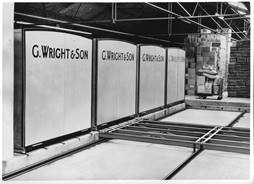 Another novel aspect of the containerisation approach was that Douggie had the lorry bodies painted in different colours. They all carried the Wrights of Dorset branding, but as people saw them out and about in different colours they became aware of the containers being independent of the lorries, thereby marking the company out as an innovator in the field. He also placed particular importance on the lorries being regularly cleaned and serviced. The arrangement for the handling of truck bodies in the warehouse provided a washing bay so that the bodies would always go out clean. The firm also employed a small number of mechanics, and equipped its own garage, so that the vehicles could be regularly maintained.
Another novel aspect of the containerisation approach was that Douggie had the lorry bodies painted in different colours. They all carried the Wrights of Dorset branding, but as people saw them out and about in different colours they became aware of the containers being independent of the lorries, thereby marking the company out as an innovator in the field. He also placed particular importance on the lorries being regularly cleaned and serviced. The arrangement for the handling of truck bodies in the warehouse provided a washing bay so that the bodies would always go out clean. The firm also employed a small number of mechanics, and equipped its own garage, so that the vehicles could be regularly maintained.
He regarded it as a matter of principle that a G Wright and Son lorry should never be seen to be emitting smoke from its exhaust, again as a reputational issue for the firm.
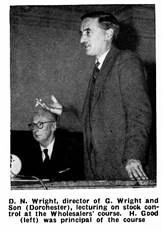 This new approach to warehousing distribution attracted quite a bit of attention. There were, for example, articles in specialist magazines such as Garage and Transport Equipment (April 1960) and The Commercial Motor (March 1960). Douggie gave lectures on the process to courses run by the National Federation of Wholesale Grocers, reported in The Grocer of 8 October 1960 (see picture right, note the cigarette!). A number of major supermarket chains, including J Sainsburys, expressed interest in learning more about the concept.
This new approach to warehousing distribution attracted quite a bit of attention. There were, for example, articles in specialist magazines such as Garage and Transport Equipment (April 1960) and The Commercial Motor (March 1960). Douggie gave lectures on the process to courses run by the National Federation of Wholesale Grocers, reported in The Grocer of 8 October 1960 (see picture right, note the cigarette!). A number of major supermarket chains, including J Sainsburys, expressed interest in learning more about the concept.
During the 1960s, Douggie increasingly sought an outlet for the practical side of his interest in the business. Given the chance, he probably would have chosen to be an engineer after his schooldays, rather than to go into the family firm. But he didn't have such a chance. So instead, in the early 1960s he started up with a colleague called Mike Pugson a small business within the G Wright and Son family called Wright Pugson Ltd. This firm was to specialise in producing machinery for the food processing trade, focusing particularly on very high quality stainless steel machinery powered primarily by compressed air.
The business produced a number of novel machines, on at least three of which Douggie obtained patents, for cutting and processing (including vacuum packing) blocks of hard cheese. In the 1960s, most of the pre-packed cheese in the UK had been through a Wright Pugson machine. Wrights of Dorset at one time produced all the individual cheese portions, wrapped in impossible to access cellophane packaging by Wright Pugson machines, for British Airways. Even in 2016, notwithstanding the fact that the company has been bought out a number of times, Marchant Schmitt Ltd of 24 West Larsen Drive, Fond du Lac, Wisconsin 54937 USA, the current owners of the Wright Pugson legacy, manufactures and markets a "Vision Cutting System cheese cutting machine" which carries a Wright Pugson label on the side.
The other particularly notable Wright Pugson (ie Douggie-designed) innovation was a machine for putting the mould into soft blue cheeses. In the 1970s, the marketing arm of the State sponsored Milk Marketing Board, known as Dairy Crest, decided there was a market for a soft blue cheese. To produce this in the volumes they would require, they realised they would have to mechanise the production process. So they approached Douggie for help. He designed a machine that would inject mould into the cheese rounds (each about the size of a Camembert). This worked well, but to get an even blue throughout the cheese, it was important that enough time was allowed after the injection process for the mould to work its way through the cheese. Dairy Crest unfortunately was so driven by what it saw as a quick profit that it got this completely wrong. They consistently pushed the product, known as Lymeswold, out too quickly, with the result that the cheese itself was chalky, and the blue tended to run in straight lines through it, following the line of the needles that had injected it.
The product was a wow for a couple of years. But it rapidly fell foul of the competition from the continent, especially in the form of Cambozola from Germany. And Dairy Crest went belly up. And then, of course, there was no call any more for the machines.
In the mid-1960s, Douggie and Robin began to recognise that there were natural limits to the extent to which G Wright and Son could grow on its own. In particular, they needed a step change in capitalisation to enable them to extend the business beyond the wholesale level to get involved more directly in the retail market. This was a time when the independent grocery sector was coming under increasing competition from the large and growing supermarket chains. If the company was to grow, it needed to be a part of that.
So they started to look around for a partner and lit upon a grocery business on the Isle of Wight called Upward and Rich. Upward and Rich had lots of money, but were constrained (totally) geographically. G Wright and Son had few constraints geographically, but were short of capital. The partnership seemed a natural one. The two firms decided to merge and to seek a quotation on the London Stock Exchange to secure a new source of investment.
After a good deal of negotiation the merged company, under the Upward and Rich name, was floated on the Stock Exchange in around 1968 (13). It is easy to pass this over as a minor detail in the history of the business. In fact, it was a very major achievement for a small family business to have worked its way up to becoming a publicly quoted entity, with shares traded on one of the major world Stock Exchanges.
As part of the deal, Upward and Rich (14) appointed the new Chairman, Robin retired, and Douggie became a Director of the new firm. He carried on for a few years, but was never fully comfortable being part of a larger business. He much preferred to be his own boss.
So in the early 1970s, he agreed with the Board of Upward and Rich that he would leave the business and take with him as part of his severance deal the real apple of his eye, Wright Pugson Ltd. Mike Pugson had left the business some time earlier, so this left Douggie in the position he liked best, running his own show. He moved the business from St George's Road to new premises which he bought on the Poundbury Industrial Estate to the North of Dorchester. And he continued to develop his Heath Robinson style machines and to run the business until he decided to retire fully in 1988. At this point he sold the firm to Mike Whittaker, but he retained the premises which he leased back to the company as a major part of his pension. In many ways this can be seen very closely to mirror the arrangement Gideon had made with Thomas Bennett (to buy the business but to lease the premises) when G Wright and Son had embarked on its first major expansion 115 years earlier in 1873.
By 1974, Upward and Rich had been bought up by the Gateway supermarket chain. In turn, Gateway was bought up by Somerfields. And in due course, Somerfields was taken over by the Coop. That is of course the natural way of the acquisitive and highly commercial world of retail trading. With hindsight, there is a strong argument to say that G Wright and Son actually gave up their independence, very much on terms of their own making, at probably just the right time.
Notes:-
(9) Source Dorset History Centre, reference D108/4(10) From the Douglas Jackman collection of 19th Century bills, Dorset County Museum
(11) Probably Joseph Adams Riggs, the brother of Gideon Denner's wife Susanna. Joseph was a farmer in Piddlehinton. It may be that Gideon had taken an interest in an insurance policy on his life, possibly in exchange for (or as a guarantee against) a loan. At different times, Gideon Denner's sons Reg and Charles went to go to live with Joseph Riggs and his sister Emily in Piddlehinton, where Charles in due course became an Assistant Farm Manager.
(12) Now held in the Dorset Records Office under reference D-2747, accession 10230a
(13) It is surprisingly difficult to find historical information about the company. There appears to be no systematic record keeping on commercial births and deaths, unlike personal ones. Corporate history, it appears, is almost entirely ephemeral.
(14) One of the things that amused Douggie about Upward and Rich was its telex address - UPRICH. When the ink was running low in the telex machine, the H could easily be misread as a K.
The Wrights had a home in Dorchester for over 200 years - from at least the time of John Wright, Gideon's father, in the late 1780s until Douggie moved to Marnhull in North Dorset in 1990.
They lived in a number of different houses. Gideon is first recorded in Grove Buildings, Fordington, in 1861. He then moved from there in 1873/74 to live above the shop in 19 High East Street. In the meantime, Gideon Denner and Susanna had moved to 1 Miller's Close, where he was by the 1871 Census, and then had moved again by 1881 to an unspecified address in Trinity Street.
In 1879, Gideon and Elizabeth were the victims of a burglary, as reported in the Police Gazette of Monday 3 November 1879:
-
"During the night of 27 October 1879 the house of Mr G Wright, High East Street, Dorchester, was entered and the following property stolen therein: about £4 worth of postage stamps, £4 in silver with a little gold tied up in a linen bag, £3 in coppers and 4 shillings to 5 shillings in threepenny and fourpenny pieces. Information to Head Constable Coward, Borough Police Station, Guildhall, Dorchester."
Gideon remained at 19 High East Street until his death in 1900. Mary Wright, Gideon's second wife and Gideon Denner's stepmother, continued to live above the shop in High East Street until she died in 1913.
It is said that Gideon left Dorset only once in his life, to go to the Isle of Wight. He so hated what he saw that he came immediately back on the same ferry, returned to Dorchester (presumably on the train) and swore that he "would never go abroad again".
At the 1891 and 1901 Censuses, Gideon Denner and the family were living at 40 South Street. William Wright describes it in his book as follows:
"We lived in South Street, at No. 40, to be precise. This was a large house which, at one time, had been a school, in which William Barnes the Dorset poet had been a teacher. Consequently, attached to the house was a large schoolroom which was reached by a covered way leading from the nursery across the roof of the kitchen. This corridor we called the Bogey Passage."
"At the end of the Bogey Passage was a small room equipped with several shelves and which, in years gone by, had probably served as a master's study. A flight of stairs led from this to the classroom which, being large, provided an excellent playground."
By 1911, Gideon Denner had moved with Susanna to "Heath View", Maumbury Way where he remained until his death in 1919. (Alfred) Denner's army records show him as living at this address when he joined up and it appears to be the address he returns to after the war. This is a bit confusing as by 1924 (15) he is recorded as being at "Heath View", Monmouth Road. This is further identified as being number 107, the middle of a small Victorian terrace. Susanna is recorded as living here in Monmouth Road at her death in 1931. It is not clear whether the road had been renamed, or whether Susanna and Denner had moved house from Maumbury Way to Monmouth Road, taking the name of the house with them.
Robert was born at 1 Millers Close and lived through his childhood and early adulthood with his parents, first at Trinity Street and then at 40 South Street. Following his marriage in 1910, he and Elsie moved to 1 Dagmar Road, a large Victorian villa behind the Great Western Station where they were when Douggie was born in 1916.
Robert and Elsie continued to live at 1 Dagmar Road until at least 1931 (16). At some point between then and when Robert died in 1936, they moved to White Gates, Treves Road (17) , to the South West of Dorchester, overlooking Maiden Castle.
Elsie married Eric Tabor in 1953. At some point, possibly during the war, White Gates was converted into two flats. Elsie, and then Elsie and Eric, lived in the first floor flat. Later, after Eric died in 1964, Elsie had a new house built in the garden. She appropriated the name of White Gates for this new house, although at some point the house became officially number 3 Treves Road, the original White Gates, now restored again to a house rather than two flats, becoming number 5.
Douggie married in 1944. Douggie's identity cards show that he and Nora were living at White Gates in June 1946, then at 2 Albert Road from 24 September 1946 to 21 March 1947, when they moved back temporarily to White Gates. Caroline was born on 2 April 1947. Then on 24 June 1947, they moved to "Greensleeves", the house they had bought on Manor Road, about half a mile away from Elsie in Treves Road. I was born here in 1951.
Then in about 1954, Douggie and Nora moved to "Loud's Piece", on the Wareham Road (now formally known as Alington Avenue), Dorchester. [Nora's mother told the story that she had on one occasion asked a policeman in Dorset, "which is the way to Wareham?", and he had replied "Put 'em on in the morning, Madam, and keep 'em on". ]
The house was so named because it was built on a piece of Mr Loud's land - the same Mr Loud that gave his name to Loud's Mill (still standing) on the river Frome at the end of St George's Road. The house had been designed and built by the Head Curator of the Dorset County Museum in the 1930s. It was just a field away from Max Gate, the house that Thomas Hardy designed and lived in for the latter part of his life. Douggie was to live here for the next 36 years with Nora, and later with Hazel, until he and Hazel moved to Marnhull in North Dorset in 1990.
The map overleaf shows how far the family moved in the 200 years before Douggie moved to Marnhull in 1990.
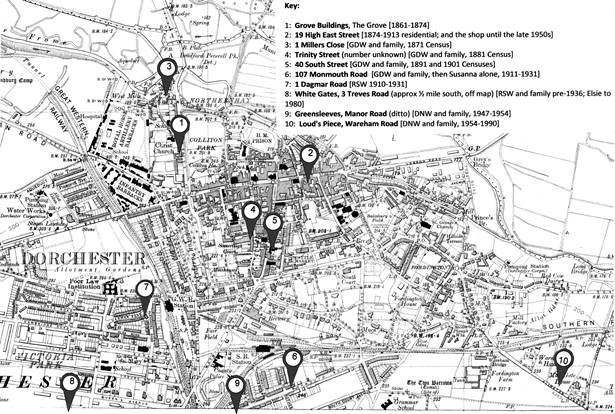
Notes:-
(15) Dorset Year Book, 1924(16) see Kelly's Directory for that year
(17) the address given on Robert's burial record. His ashes are at St Georges Church, Fordington.
Douggie got engaged to Nora Hermoine (18) Hatton-Jones in the spring of 1944. Nora was serving in the First Aid Nursing Yeomanry (known as "the Fannies"), see picture below.
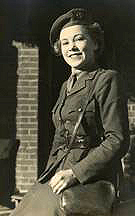
 Nora was based at Tangmere Aerodrome in West Sussex. Her job was to teach morse code to British and other allied agents in the Special Operations Executive (SOE) who were to be dropped behind enemy lines in France and elsewhere to report on and disrupt the German war effort. She and her colleagues were also responsible for receiving and recording messages from these agents. This acted as a safety check insofar as the FANYs had become very familiar during their training with the morse equivalent of the "handwriting" of individual trainees, so they could tell instinctively whether it was the expected agent or someone else sending the messages they were receiving.
Nora was based at Tangmere Aerodrome in West Sussex. Her job was to teach morse code to British and other allied agents in the Special Operations Executive (SOE) who were to be dropped behind enemy lines in France and elsewhere to report on and disrupt the German war effort. She and her colleagues were also responsible for receiving and recording messages from these agents. This acted as a safety check insofar as the FANYs had become very familiar during their training with the morse equivalent of the "handwriting" of individual trainees, so they could tell instinctively whether it was the expected agent or someone else sending the messages they were receiving.
Nora made the mistake of falling in love with one of her trainees. She was devastated when she was later receiving a message from him from France which was cut off abruptly in mid-flow. He had apparently been caught by the Germans red handed sending back a report to Tangmere.
Nora married Douggie (in her own words, "on the rebound") on 6 October 1944 in Bersted, Sussex. All else apart, this meant that she could leave the FANYs and remove herself from the risk of history repeating itself. Pictures of them on their wedding day (Lieut DN and Mrs NH Wright) and probably shortly after the end of the war are shown right and overleaf. Note in the second photograph the cigarette in Douggie's hand.
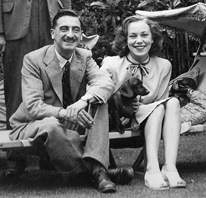 On 9 January 1946, Nora gave birth to their first child, a son Robert Christopher. She had gone home to her parents for the birth in Bognor Regis. Douggie appears to have been in Germany with the Dorset Regiment at the time, and there is no evidence of his having been able to take leave to be home for the birth or immediately after it. Sadly, Christopher (as he was to be known) was born with some form of deformity. He survived only nine hours. He is buried in Bognor Regis Cemetery.
On 9 January 1946, Nora gave birth to their first child, a son Robert Christopher. She had gone home to her parents for the birth in Bognor Regis. Douggie appears to have been in Germany with the Dorset Regiment at the time, and there is no evidence of his having been able to take leave to be home for the birth or immediately after it. Sadly, Christopher (as he was to be known) was born with some form of deformity. He survived only nine hours. He is buried in Bognor Regis Cemetery.
On his return from Germany and his demobilisation from the Army, Douggie and Nora lived initially with his mother at White Gates. They then moved to rented accommodation at 2 Albert Road Dorchester from 24 September 1946 to 21 March 1947, when they moved back temporarily to White Gates. Nora was by this time again heavily pregnant. This must have been a very worrying time for them both as they had been told on Christopher's death that they would never be able to have a son that would survive. Nora was by her own account very unhappy to be pregnant again so soon, and petrified that she would give birth to another boy. In fact, their fears were unrealised, and Caroline, healthy and fit, was born in Dorchester on 2 April 1947.
On 24 June 1947, they moved to "Greensleeves", a small 1930s house (now almost three times the size that it was then) that they had bought on Manor Road, about half a mile away from Elsie in Treves Road.
Douggie got back into the family business. He also got together with a group of like-minded business friends including accountant Maurice Edwards, car dealer Paul Channon and builder Bob Ricardo, to set up a Dorchester branch of the Round Table organisation. Its first meeting took place on Tuesday 21 April at the Antelope Hotel. Douggie was its first Chairman.
By this time, I had been born, on 2 March 1951, at home at Greensleeves. The story went that the midwife who was attending the birth was apparently rather inexperienced. On realising that things were coming to fruition, she rapidly absented herself to get hot water and clean towels, leaving Douggie to deliver me. Fortunately, the doctor arrived at the same time, as I was born with a caul. This is very rare, and deemed to be very lucky. It is where, in one in 80,000 births, the baby's head is covered by the amniotic sac. It is very easy to deal with - simply a matter of removing the sac from the head - but it is lucky that the doctor was there to do it, as it is unlikely I'd have survived without immediate action being taken to enable me to breathe. It was said that Douggie suffered from piles for weeks afterwards from the shock of being so intimately involved in my birth.
Although doubtless there were concerns, given what had happened to Christopher, I was pronounced to be obviously a boy and fully healthy in all respects. [That said, I have had to have an aortic valve replacement at the relatively early age of 62, which suggests a congenital malformation of the heart. This leaves open the possibility that Christopher had some sort of heart problem - but no-one will ever know.]
In 1954, Douggie and Nora bought Loud's Piece for £4,500. And that is where they brought up both Caroline and me over the next 20+ years. A picture of Douggie and Nora, taken at some sort of formal dinner (possibly Round Table, given the badge in Douggie's lapel) from about this period is shown below. Again, note the cigarette, this time in Nora's hand.
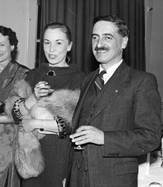 Over time, they completely remodelled the house. A hard tennis court was built. And a small heated swimming pool was dug. Walls were removed (to turn a small playroom and next door dining room into a larger dining room, to extend the sitting room, to turn two small bedrooms into a larger master bedroom with, in due course, an en suite bathroom, and to carve a further guest bathroom out of what had previously been a box room). As we grew, the house seemed to grow with us.
Over time, they completely remodelled the house. A hard tennis court was built. And a small heated swimming pool was dug. Walls were removed (to turn a small playroom and next door dining room into a larger dining room, to extend the sitting room, to turn two small bedrooms into a larger master bedroom with, in due course, an en suite bathroom, and to carve a further guest bathroom out of what had previously been a box room). As we grew, the house seemed to grow with us.
Caroline and I were sent to boarding school. Caroline was found to be "a bit difficult" and changed schools from time to time. I went initially to Perrot Hill School near Crewkerne, and then on to Canford School near Wimborne.
Nora was heavily involved in riding. She had a series of horses of her own most of my childhood, all of which seemed to have problems of one kind or another, either physical or behavioural. She kept her horses at the livery stables at Fordington House which were run by Lionel Barnes and his wife Ena. Lionel was very much larger than life both physically and in his character. He had served in a (horse) mounted company with the Dorset Regiment in Egypt in the First World War and was a great fund of now largely forgotten anecdotes about his experiences. He used to walk from his house on Fordington Green to Loud's Piece every Sunday morning where he'd sit in our kitchen and drink a couple of neat gins to fortify him for the walk back, usually via a quick one in The Bull at the bottom of Fordington Hill.
In exchange for reduced livery fees for the horse, Nora would give riding lessons at the stables and take people out on rides. She also one year entered the Three Day Event championship in the Dorchester Show, involving cross country riding, dressage, and show jumping. She didn't do very well, but it was quite an achievement even to be able to qualify even to enter the competition. She had something of a reputation with one horse for hacking out to the Wise Man pub in West Stafford where she'd have a couple of her favourite drinks (whisky and cider - known in the west country as a stone fence, because "if you hit it you really know about it") and the horse would be given the ullage from the beer trays. Both of them would make their way home slightly the worse for wear.
One summer in the 1950s, Douggie and Nora and Lionel and Ena boxed four horses down to Porlock in Somerset and rode back over several days to Dorchester, stopping off to stay in pubs on the way. It was probably about the last time it was possible to find enough pubs with stables and/or fields in which the horses could stay overnight to make such a trip possible.
Douggie was very keen on Spain, no doubt partly because of his experience of the country during the war. He took the Spanish edition of the Reader's Digest monthly to improve his language skills. He and Nora used to travel there for two or three weeks most summers, either flying down or driving down through France [which must have been quite a trial as, at the time, Nora didn't drive]. I recall his being very impressed one year when something went wrong with the innovative "fluid flywheel" clutch on the Lanchester car they were driving. The mechanics in a local Spanish garage, who had clearly never seen such a thing in their lives before, managed to strip it down, fix it and rebuild it overnight.
Caroline and I weren't involved in these trips which usually but not always occurred during term times. But I do remember very many happy breaks with Nora's parents in Bognor Regis, especially with her mother (Henrietta, but known to everyone for some reason as Toots).
Douggie also in the early 1960s decided he wanted to learn to fly. He went for many lessons and became very competent. But in the end he was refused a pilot's licence because of his eyesight. I recall him being very fed up about this.
All in all, Douggie and Nora had a pretty comfortable life. They weren't wealthy, but they were well off and they wanted for little. They had good holidays, they could afford to send their children to boarding schools, they had all the material goods that were available and they had a marriage that, despite its occasional rocky moments, was generally pretty sound.
Then in 1969, they experienced a major disruption to the planned pattern of events. Caroline had left school at 16 (in 1963) to go to drama college - the Arts Educational Trust - in London. She was a good actress. But like most actresses, she found it difficult if not impossible to find work. She mixed with other struggling artistes and at the age of 20 found herself pregnant. The father was another out of work actor called Keith Bowles. They married. Their daughter, Penelope Judith, was born in 1967.
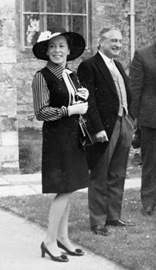 For a while they stuck together trying to bring up the baby. But then Caroline left, leaving Keith with Penny. He too struggled on for a year or two, but eventually was unable to continue to provide for her. In the summer of 1969, he rang Douggie and said he was going on holiday for three weeks. He'd leave the child at Bournemouth Station, and would be grateful if Douggie and Nora would be good enough to pick her up and look after her till he got back.
For a while they stuck together trying to bring up the baby. But then Caroline left, leaving Keith with Penny. He too struggled on for a year or two, but eventually was unable to continue to provide for her. In the summer of 1969, he rang Douggie and said he was going on holiday for three weeks. He'd leave the child at Bournemouth Station, and would be grateful if Douggie and Nora would be good enough to pick her up and look after her till he got back.
They didn't hear from him for three years. Caroline had no interest/means to look after her. So Douggie and Nora took her on, sending her to nursery and then infant school in Dorchester and bringing her up generally as their own. Douggie was 53; Nora was 45.
Sometime during the next few years it became accepted as fact that Douggie and Nora were going to bring Penny (known as Pebble - because she had to be convinced she wasn't the only Pebble on the beach ) up. So they got on with it.
Until on 24 February 1974, Nora suffered a massive angina attack while out walking the dogs on a sparklingly sunny spring morning. And dropped dead. The last picture of her and Douggie, taken at a wedding the week before she died, is shown left.
Notes:-
(18) Nora's second name (Hermoine rather than Hermione) comes apparently from a spelling mistake made by her father on her Birth registration form. In the 1960s she changed her name by Deed Poll to avoid having repeatedly to correct official documents to make them appropriately wrong.(19) There is an alternative version of this rationale which made itself into the Telegraph letters pages many years later. A teacher wrote in, in connection with a run of correspondence about amusing children's names, to say that he had taught some years earlier a girl who was known as Pebble "because, he'd been told, she had been conceived on Chesil Beach".
Douggie was hopeless on his own. Like most men of his generation, he couldn't cook. He survived on boiled eggs and Marks and Spencers ready meals. Even then, he struggled. Despite this, he felt very strongly that he had a continuing responsibility to look after Penny if her own parents were unable to do so.
Penny was spending the working week living with the Sibleys in Icen Way, Dorchester. Mrs Sibley had for some time been Douggie and Nora's cleaner; Mr Sibley was a fireman. She went to Loud's Piece for the weekends. I went home from university in Southampton every other weekend to help. But these arrangements were not really sustainable in the long run.
Douggie found himself spending increasing amounts of time with Hazel Southcombe, one of Nora's closest friends, who lived in Weymouth. Hazel had been widowed the year before. Towards the end of May, about twelve weeks after Nora had died, Douggie told me that he and Hazel had decided to marry. They married on 16 September 1974 at Weymouth Registry Office. A picture of them from around that time, at Lulworth Cove, is shown below.
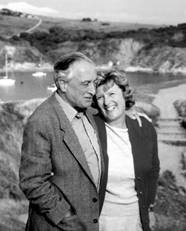
Theirs was a marriage fortunately based very much on love and mutual respect. It was absolutely not a marriage of convenience, although it was in practice very convenient insofar as it enabled Douggie to continue to look after Penny. Hazel had had no children of her own. She was pretty heroic in agreeing, at the age of 45, to take her on. Penny, for many obvious reasons not least the fact that she was being brought up by people old enough to be her grandparents, was not always easy.
The alternative for her, though, would have been a children's home.
Douggie and Hazel continued to live at Loud's Piece, with Penny. Being much older than the parents of her contemporaries, they couldn't offer her much of a normal home life, so they paid up to send her to boarding school. And at the age of 16 she decided that she wanted to be an actress. So they put together the money to send her to drama school. Douggie's mother, Elsie, died in 1980.
In 1983, I married Jane Augier at Stourton Church in Wiltshire (see picture overleaf). Penny was a bridesmaid. Jane and I later went with my work to Hong Kong for three years (1985-1988). In 1985, our first son Edward (Douggie's first grandson) was born. He died after four days, having contracted an infection in hospital. In 1987, Hannah was born in Hong Kong. On our return to the UK, Charlie was born in 1989, and Becky in 1991.
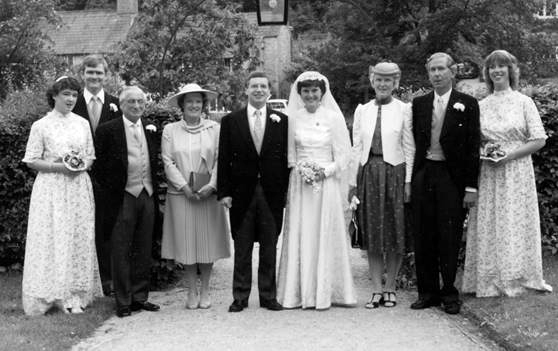
L-R, Penny Wright, Ian Gordon (best man), Douggie, Hazel, Rob, Jane, Diana and Ashley Augier (Jane's parents), Alex Bridcut (bridesmaid)
After Penny had left home and Douggie had sold Wright Pugson in 1988, Douggie and Hazel concluded that Loud's Piece was really too big for them. Douggie wasn't keen on staying in Dorchester; he thought it was too big to be a comfortable place in which to be retired. So in 1990, he became the last Wright to leave Dorchester when he and Hazel moved to Marnhull in North Dorset.
Douggie threw himself enthusiastically into local activities. He and Hazel actively supported local charitable fundraising events for many good causes and for the Conservative Party. Douggie had been an early adopter of personal computing, and he kitted himself out with a high quality computer and printer on which he made up and printed a wide range of publicity material for local charities. He became a member of an informal share buying group (the Shottsford group). He took on for several years the task of finding speakers for the monthly meeting of a local Probus group (largely made up of retired "professional and business" people).
He and Hazel also enjoyed many foreign holidays, in the early days of their marriage in the Far East and elsewhere. Later, they became great devotees of cruises around the UK and in the Mediterranean, particularly with the Hebridean line - noted for providing great luxury at great expense. Douggie on one occasion remarked on the fact that the ships provided free champagne with every meal, at which I felt I had to point out that "free" was a relative concept, considering how expensive the cruises were.
Penny got engaged to Hugh Baker, the son of an ex-Naval officer, and in 1997 Douggie and Hazel organised their wedding in Marnhull. They were married by Douggie's very good friend, Canon Norman Barnett. The wedding reception was held at the Tithe Barn at Hinton St Mary. Douggie's other granddaughters, Hannah and Becky, were bridesmaids. Penny and Hugh in due course produced three great grandchildren (Charlotte, Phoebe and Oscar), although Phoebe sadly died very soon after birth.
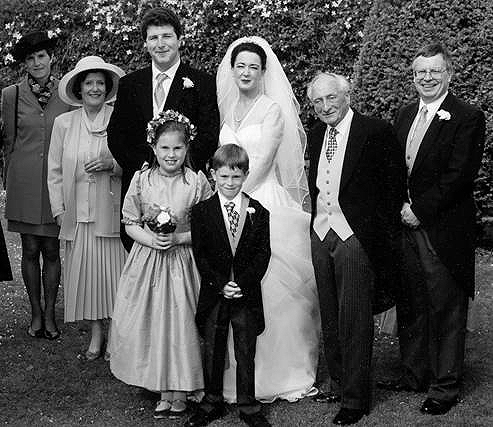
Penny's marriage to Hugh Baker - 10 May 1997:
L-R Jane Wright, Hazel, Hugh Baker, Hannah Wright, Charlie Wright Penny Wright/Baker, Douggie, Rob
[Becky Wright's dress can be made out in the background just behind Douggie and Rob. She was cold and fed up!]
Penny and I jointly threw Douggie and Hazel a lunch party at Plumber Manor (outside Sturminster Newton) on 11 September 1999 to celebrate their 25th wedding anniversary (see pictures, below).
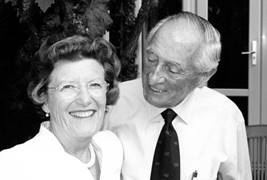
Douggie and Hazel, 11 September 1999
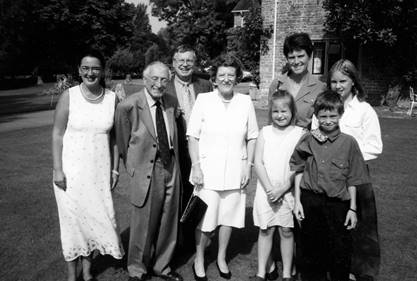
The Wrights at Douggie and Hazel's 25th Wedding Anniversary party, 11 September 1999.
L - R: Penny, Douggie, Rob, Hazel, Becky, Jane, Charlie, Hannah
On 28 April 2001 Douggie attended the Dorchester Round Table's anniversary dinner, having been its first chairman 50 years earlier. Then on 26 November 2001, shortly after returning home from a haircut in Sherborne, he suffered a massive stroke and died almost instantly in his armchair. He was cremated at Bath crematorium. A memorial service was held at St Gregory's Church Marnhull, on 8 December 2001. A good crowd of local people, and some not so local, turned out for the occasion. It is clear that Douggie was liked by lots of those he came across in his long and full lifetime. The address that I made on that occasion is at Appendix VII.
At his request, Douggie's ashes are scattered in Thorncombe woods near Thomas Hardy's birthplace in Upper Bockhampton outside Dorchester. Hazel has asked that, in due course, her ashes be scattered there also. There is no memorial artefact (stone, or bench, or whatever).
The final word
The final words in this narrative are best left to the last male member of the Wright family line, Douggie's grandson Charlie. In 1998, aged 9, he was asked at school to write a description of his grandfather. He wrote:
"My Grandfather
His name is Douglas Wright, but everyone calls him Douggie. I call him Grandpa. He's married to Hazel who I call Granzie.
Grandpa is not very tall but is very thin. He has no hair on his forehead but on the rest of his head his hair is browny white. He goes brown very easily in the sun. He is 82 and has a lot of wrinkles on his face. His nose is quite big and pointy. His eyes are brown and his eyebrows are grey.
He likes telling jokes and laughs a lot but he also gets very tired. He doesn't like eating green vegetables but he loves meat, potatoes and cheddar cheese. Grandpa used to have his own business. He made stainless steel equipment. He sold his company a few years ago and now he loves working on his computers at home. He has two computers and four printers. He loves watching wrestling and Coronation Street on TV."
Marnhull
May 2016APPENDIX I - WRIGHT FAMILY TREE
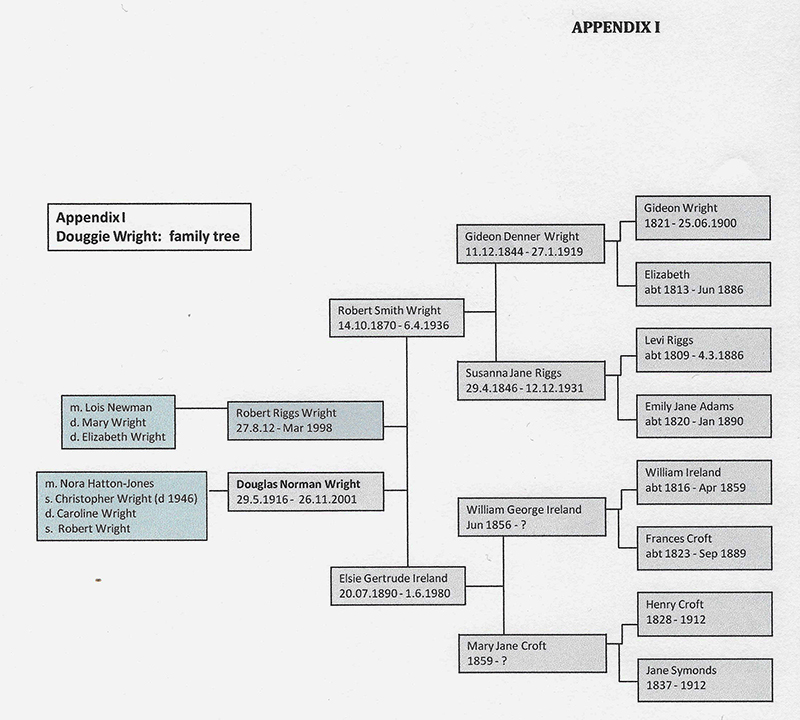
APPENDIX II - THE FAMILY'S INVOLVEMENT IN METHODISM IN DORSET (20)
Much of the detail in this Appendix is taken from an excellent book entitled "Methodism in Dorset: A Sketch" by John S Simon, published by James Sherven, St Mary St, Weymouth in 1870. This is very hard to get hold of, but a copy is held in the library of the Dorset County Museum in Dorchester. Other material comes from Deeds held by the Dorset History Centre (under reference NM2), village websites and other web summaries.
The Wesleys
Methodism had a strong foundation in Dorset. The father and grandfather of John and Charles Wesley, the leading lights of Methodism in the early 19th Century, were born and brought up in Dorset. Their grandfather, John Westley [sic], was born about 1636 probably at Bridport, although some authorities claim he was born in Devon. His early education was gained at Dorchester Grammar School and afterwards at New Hall, Oxford.
Wesleyanism in Dorset in the late 1800s
In the early 1800s, most Methodist congregations met in private houses, invited by individual members. Ministers were itinerant, moving from parish to parish to preach on request, often travelling long distances on a Sunday from a meeting early in the day in one village to another village for a midday meeting, and yet another village for an evening service.
Eventually, local congregations started to pull together the funds to build permanent churches. In the Dorchester area (known as a "Circuit"), the first significant chapel was completed in Bere Regis in 1828 for a sum of £120. This was followed by Kingston (1839, £120), Dorchester (1840, £728), Whitchurch (1846, £246), Bere Heath (1850, £121), Piddletrenthide (1857, £276), Dewlish (1859, £140), Charminster (1860, £105), Tolpuddle (1862, £212), Broadmayne (1865, £309), Milton Abbey (1865, £236), Sydling (1867, £390) and Milbourne (presumably Milborne St Andrew, 1867, £360). By 1870, the church had the capacity to hold services for more than 1800 people in permanent buildings, including a rented chapel in Cerne Abbas.
The Dorchester Chapel was built in Durngate Street (previously known as Wood and Stone Street, named after a pub called the Wood and Stone Inn on the corner with South Street that was knocked down for the building of the church - another triumph for temperance!).
Levi Riggs (Douggie's great grandfather) was a leading influence in much of this building work, alongside Gideon and later Gideon Denner Wright. So, for example, the Bere Regis village website (at www.bereregis.org/BereHeathMethodistChapel.htm) tells us:
-
The Society at Bere Heath appears to have been formed sometime between 1815 and 1829. In the Tolpuddle Martyrs' Memorial Chapel, there is a copy of a Weymouth Circuit Plan for December 1829 to February 1830, and Bere Heath was one of the preaching places listed.
Before the chapel was built, the Society met in the house of Mr Benjamin Romain, of whom it is said that he was a Local Preacher, Class Leader and later Chapel Steward "faithful to the Church of his choice." The first Trust was formed in 1849, with the following members: Benjamin Romain, John Ricketts, George Romain, Levi Riggs, Henry Ainsworth, George Riggs [Levi's brother], Isscher Day, George Cole, Edward Galpin, Eli Savoury, William Hammett and Robert Hoare. The building was erected in 1850 on a site kindly given by Mr Robert Hoare, at a cost of £120.18s.8d voluntarily contributed by members of the Society and by friends in the Dorchester Circuit. The chapel was opened by the Rev. J. Smeeth of Poole on 24 October 1850.
It was found in 1889 that only two trustees were surviving so a new trust was formed including the remaining two former members, William Hammett and J.W. Barrett, and the following new members: William Snook, William Crocker, Robert Thorne, James Henvill, Benjamin Baker, Edwin Shave, Elias Joiner, Alphonso Wolff, Gideon Wright [Note: not clear if this is Gideon, aged 68, or Gideon Denner, aged 45], George Sanders, Henry Marsh, Walter Beckingham and Thomas Besant.
1900 marked the 50th anniversary of the chapel. The Choir from Whitechurch joined the celebrations. The thrill of the latter event still remains in the mind of the oldest member, Miss Jane Wilcox. The same lady also remembers the preaching of one of the original Trustees, Levi Riggs, who was also a Circuit Steward. From what she tells me his preaching carried great conviction. The indebtedness of the Circuit to this man is noted in John S. Simon's book "Methodism in Dorset".
.... So we come to our Centenary, finding that our Chapel premises have served us well, and there is every reason to expect many more years of fellowship within its walls.
In connection with the Centenary, services were held on Sunday 12 November 1950 at 3.00pm and 6.00pm, and on Wednesday 15 November, 1950 at 7.00pm. On Sunday the special preachers were Mr J.I. Miller of Poole and Rev Wilfred E. Curry, Superintendent Minister. On Wednesday evening the Chairman was Mr L.H.Gray of Milborne St Andrew, and the speakers Rev A. Gordon James and Rev F. Balch (21), former ministers of this circuit.
On 19th November 1966, the first ever marriage service took place there, after the building had been licensed for weddings in that year.
In a similar vein, the Maiden Newton website (22) says that:
-
"Methodism in Maiden Newton has a history of more than a century. In a small book called Methodism in Dorset by John Simon [op cit] it is recorded that in 1870 "a work has been recently commenced through the instrumentality of Messes Bush and Gideon Wright, jun’r" [ie Gideon Denner, then aged 26]. This is a reference to plans to erect the present chapel on the Crewkerne road.
"This building was erected in 1871 at a cost of £345 by I. Guy and Son, on a site purchased from Maiden Newton Mill. Furnishings cost another £35. The debt on it was not cleared until 1924, when the trustees (of whom there were nine out of an original eighteen) sold Waterloo Cottages at the back of the Chapel to Mr. Dubbin, a working miller in the village. It is interesting to discover from the Circuit Plan of Preachments that in 1880 there were 31 members of this Chapel and they gave about 10/- each p.a. for its upkeep, etc. It was opened on Good Friday, April 7th, 1871 by the Rev. A.M. Auley of London."
A booklet on Dewlish, produced by local residents for the Milennium, notes that the Dewlish Methodist chapel was built originally on land bought from John Dunman in 1843 for £68. Trustees included Levi Riggs. The major village fire of 1859 destroyed the building which was then rebuilt on the same site. It goes on to say:
-
"There was considerable local opposition to Methodists when the chapel was first built and the door was therefore put on the side of the chapel. A massive boot-scraper fixed in the side wall can still be seen with much evidence of wear from the hob-nail boots which the farm workers used to wear. A prayer meeting was held every Sunday at 7 am and Levi Riggs used to come on horseback to attend what he called "knee-drill". His preaching was well known".
-
"The cause here [in Hilton] is very primitive; it was commenced in the year 1865. Officiating in the evening, we rode from Hartfoot Lane and speedily found ourselves under the comfortable roof tree of Mr Levi Riggs of Chessilbourne (sic) where we spent the night. This gentleman has been Circuit Steward for about 37 years and his name is inseparably connected with Methodism in this part of Dorset. His house is the young preachers' home, and a more pleasant one it would be hard to find ...
The walk over from Cheselbourne to Dewlish is no great tax upon the physical powers of a country preacher at least. Methodism was introduced into Dewlish by persons who came from Tolpuddle ...
We came to Milborne St Andrew. For many years the class here was met by Mr Riggs, who had to walk four or five miles to the scene of his cheerfully discharged labours".
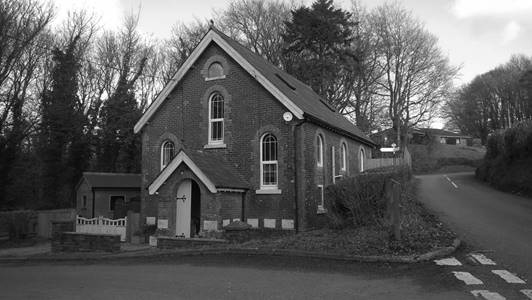
Simon also says:
-
"Mr Mason [the Rev John Mason, appointed to the Dorchester circuit in 1838] appointed a committee to carry out a scheme [for the building of chapels] which he matured, and the first piece of work accomplished was the building of Kingston Chapel. Before that time services had been conducted in a cottage, possessing a wooden partition which was removed during the hour of worship. A piece of land being secured, the erection commenced. Chalk is a very considerable ingredient in the composition of a mud wall, and in the neighbourhood there was a pit to which it was supposed all the inhabitants of the village had access. However, the activity of the Methodists had provoked great opposition, and when the walls of the chapel had risen a few feet from the ground, a summons arrived demanding the appearance of the builders at Wareham Court. Thither Mr Mason and Mr Riggs went; but when the case came on, the Judge dismissed it. Nevertheless, they were directed to procure chalk from elsewhere, and so, in obedience to such direction, Mr Riggs took his cart and horses to another pit, and thereby saved very considerable expense for hauling. Mr Riggs also laboured masonically, and used to think that, if God spared his life and permitted him to preach the gospel in the building, he should be abundantly rewarded. In the year 1839, the chapel was opened."
Simon's book also comments on the Dorchester chapel:
-
The chapel in Dorchester is the result of the continuous toils of the Mr Mason before mentioned. In Durngate Street the chapel stands. This was the best site obtainable.
"On the morning of the 22nd December, 1840, that earnest minister was discovered, pick-axe in hand, levelling the ground in front of the door and thus forming a footpath for the coming congregation. On being made aware of the presence of a spectator in the person of Mr Riggs, he very truthfully assigned this reason for his exertions, "We Dorchester men must work for our living!" a sentence which has received plenteous illustration since its utterance ... From the circular issued on the occasion of the opening services we learn that the managing committee consisted of Messrs Thomas Atherton, Henry Raggett, Levi Riggs, George Cole and W Bartlett."
Deeds of 21 September 1859 refer to Gideon Wright and others committing £100 to buy a cottage and garden in North Street Charminster from John Satchell, a shepherd, for the building of a chapel. A similar deed of 18 August 1882 relating to the Tolpuddle chapel has William Hammett of Tolpuddle, builder, selling land to Levi Riggs of Cheselbourne, farmer, and Gideon Wright of Dorchester, grocer, together with Lewis Hammett of Tolpuddle, joiner, and William Loveless of Tolpuddle, grocer, and others for the building of a chapel. Hammett and Loveless are surnames that crop up in the story of the Tolpuddle martyrs. The signatures from this document and its title page are shown below.
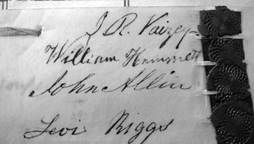
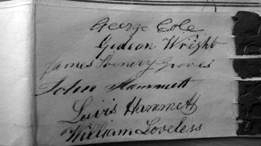
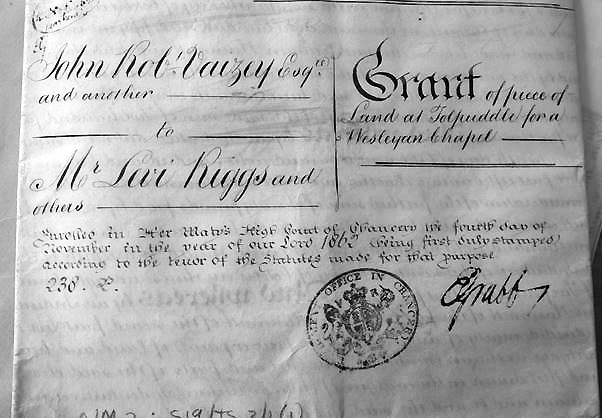
In August 1891, Gideon Denner was one of a small committee of members who put their names to a printed document soliciting donations for an extension to the East Fordington chapel (see below) (24).
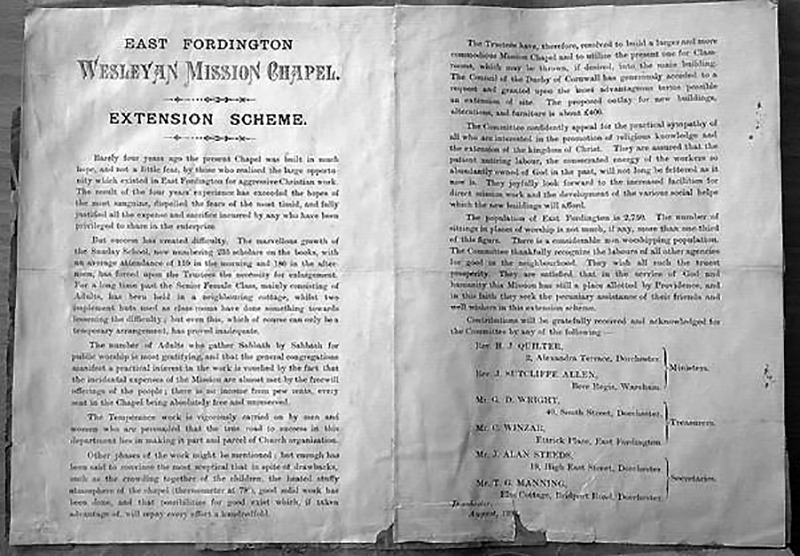
This document notes that, in the four years since the building of the chapel itself, "experience has exceeded the hopes of the most sanguine, dispelled the fears of the most timid, and fully justified all the expense and sacrifice incurred by any who have been privileged to share in the enterprize". The Sunday school is said to have "235 scholars on the books" in a morning and an afternoon session. The document seeks donations to go towards the raising of £400 for new buildings, alterations and furniture to enable the church to respond effectively to this level of demand. There is a story passed down from Douggie which relates that Gideon Denner approached Thomas Hardy for a donation to the Methodist cause, possibly in relation to the East Fordington chapel extension. The request came back with the simple annotation in Thomas Hardy's hand: "No. T.H.".
An article from the Dorset Chronicle (25) of Thursday 17 May 1894 reports on the opening of the new Wesleyan Chapel in Piddletrenthide on Whit Monday of that year, eight years after Levi had died. In the evening, "a public meeting took place in the new chapel , when every seat was occupied, the pressure being so great that even the aisles were filled and many were unable to find seats." "The chair was taken by ... and there were also present Mr G Wright, Mr G D Wright (Dorchester), ... Mr J A [Joseph Adams] Riggs and Mr H R Waterman, joint secretaries, ....".
Amongst other speakers, including a "vigorous address" from The Rev G M C Fish (Chard),
-
"Mr E B Dingley of Sherborne said he was proud to be a Dorset man and he alluded to the remarkable improvement that had been effected in the condition of the Dorset labourer. He regarded to the great bulwark of Protestantism in the country. (Applause). He touched on the designs of the Romanists on England and said that Rome had her plans perfected as far as the Church of England was concerned. The greatest obstacle, however, to her advance would be the union of Methodism, and he believed they would be able to meet every effort of the Church of Rome in her advance in this country. If the Wesleyan Methodists were only true to their principles he believed it would be a long time before Ritualism and Popery had conquered in the County of Dorset".
The Rev Fish said:
-
"Indifference was the crying sin of the present day and one that he believed to be far more fatal than infidelity and the various forms of immorality. But there was a movement which demanded the most vigorous efforts and that was the enormous spread of sacerdotalism [the principle that only priests could communicate with God] in the country villages. Efforts were being made to stamp out Methodism in the villages, but he was confident that the attempts of the sacerdotalists would fail. (Applause). The new chapel at Piddletrenthide was a standing protest against indifference and sacerdotalism.
Strong stuff, taking on both Catholic doctrine and the insistence of the Church of England that only ordained priests had the authority to conduct services and to communicate with God.
It is clear from these documents and others that the Riggs family (Levi and his brother George) and the Wright family (Gideon and his son Gideon Denner) were very much involved in spreading the influence of Primitive Methodism or Wesleyanism throughout North Dorset. A small booklet entitled "The Methodist Church South Street Dorchester 1875 - 1975: The Wesleyan Society in Dorchester 1825 - 1975" was published in January 1975 as part of the Centenary celebration of the Dorchester chapel. This noted that Gideon Denner Wright "who was a circuit steward and a driving force behind the construction of many of the circuit churches" was commemorated as such by a plaque in the South Street church to the right of the pulpit. Sadly, the Dorchester chapel was demolished in 1981 to make way for a Waitrose supermarket (surely some historical comeuppance here!) and the South Street Methodist church merged with the United Reformed Church, and moved to its building (also in South Street). Memorials from the Methodist church were moved to storage elsewhere.
A photograph of the plaque is reproduced overleaf, thanks to the kindness of the United Church's Chapel Secretary, who dug out the memorial from the place where it is in safe keeping. A similar photo of the plaque is in a memorial book which is kept in the foyer of the new United Church in South Street, Dorchester.
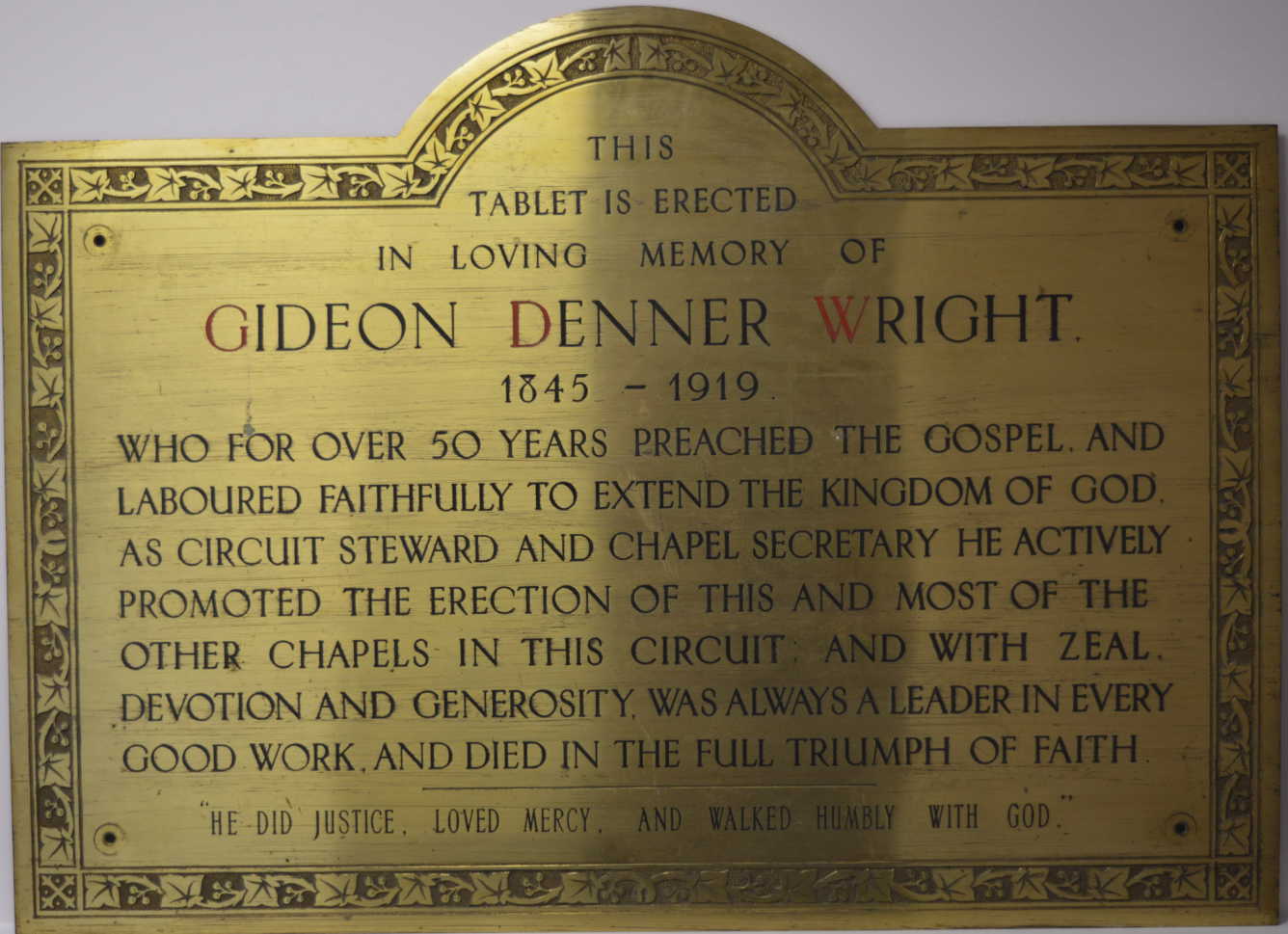
Of the twelve children that survived him, Gideon's eldest two daughters both married significant figures in the Wesleyan Methodist Church. Elizabeth married Harold Waterman, from Piddletrenthide. Ellen married Frederick Balch who was a Methodist minister in several places through his life, including Chard, Totnes and Bournemouth. His youngest but one son, Edgar Dunstan Wright also in 1918 married the daughter of a Wesleyan Minister.
Gideon's second surviving son, William Joseph, after starting a career in banking, became ordained into the Anglican church. He retained, however, a very strong belief in the merits of breaking down the divisions between different Christian religions, and spent much of his career seeking to build bridges between them. He was made a Canon, and Dean of Nairobi Cathedral in Kenya from 1929 - 1939, before taking up livings in Suffolk and Essex in his later years.
Notes:-
(20) In passing, it should be noted that this Appendix is included for its interest value as background alone, not because Methodism was any significant part of Douggie's life. Indeed, he was much amused by a comment made to me by a friend in Canada (Murray Wires) whose family was also strictly Methodist. Murray asserted that his grandparents would "never have made love standing up, in case people thought they were dancing"..
(21) Almost certainly Frederick Balch, the husband of Ellen Marion Wright (1873 - 1963), Gideon Denner's daughter - see Appendix III.
(22) https://www.maidennewton.info/the-independent-churches
(23) Dorset History Centre, Dorchester; refs NM2.S7, S10 and S11
(24) Dorset History Centre
(25) Dorset History Centre
GIDEON DENNER WRIGHT AND OFFSPRING
Birth dates taken from the "family Bible"; dates of death, where known, from research
Born |
Died |
Age |
|
Gideon Denner Wright |
11 December 1844 |
27 January 1919 |
74 |
Susanna Jane Riggs |
29 April 1846 |
12 December 1931 |
85 |
Married at Cheselbourne Church |
15 July 1869 |
||
Robert Smith Wright |
14 October 1870 |
6 April 1936 |
65 |
Elizabeth Emily Wright |
14 January 1872 |
1 June 1927 |
55 |
Ellen Marion Wright |
25 March 1873 |
? 1963 |
90 |
George Levi Wright |
23 December 1875 |
pre-1881? |
<6 |
Margaret Mary Wright |
19 March 1876 |
? |
|
Emily Jane Wright |
23 September 1877 |
? |
|
Blanche Susan Wright |
15 December 1878 |
? |
|
Eliza Annie Wright |
13 May 1880 |
2 October 1881 |
<2 |
William Joseph Wright |
4 August 1881 |
29 March 1954 |
73 |
Reginald Francis Wright |
9 January 1883 |
23 December 1963 |
80 |
Charles Henry Wright |
8 October 1884 |
? 1958 |
|
Douglas Riggs Wright |
20 July 1886 |
14 December 1910 |
24 |
Edgar Dunstan Wright |
18 November 1888 |
? [prob in South Africa] |
|
Alfred Denner Wright |
25 July 1890 |
18 December 1965 |
75 |
Elizabeth Emily Wright
Married Harold Waterman in 1889. Had three sons (John (1900), Robert (1900, nb not a twin) and Aubrey (1902 - 1992) and one daughter (1904). Was visiting Joseph Adams Riggs at Manor Farm in Piddlehinton with her two baby sons on the night of the 1901 Census. Was living with her husband and children in Buckland Newton at the time of the 1911 Census, aged 39. Harold Waterman, alongside Gideon Denner, was a leading light of the Methodist Church, especially in Piddletrenthide. Elizabeth died a widow on 1 June 1927 (aged 55). Probate was granted inter alia to her son Robert who was by then a Wesleyan Minister.
Ellen Marion Wright
In 1901, Marion (aged 28) was living in Chard, Somerset, with her husband Frederick Balch, a Wesleyan Minister. They had three children: Marjorie (1905 - 1974) born in Yeovil, Somerset, and twin boys Frederick (1907 - 1984) and Henry (1907 - 1943) born in Totnes, Devon. Ellen died in 1963 in Bournemouth, Hampshire aged 90.
George Levi Wright
It seems that George did not survive childhood as he is not shown in the 1881 Census (when he would have been around 6 years old).
Margaret Mary Wright
Margaret is listed in the 1881 Census, aged 5, but not in the1891 Census when she would have been 15 and probably still at home if she'd survived.
Emily Jane Wright
Emily is listed in the 1891 Census, aged 14, but not in the 1901 Census, by which time she would probably have left home anyway.
Blanche Susan Wright
Blanche is listed in the 1881 Census, aged 3, where she is described as being epileptic. In the 1891 Census, aged 13, she is still at home, and described as suffering from fits.
Eliza Annie Wright
Eliza is listed in the 1881 Census, aged 1, but not in the 1891 Census. Her death on 2 October 1881 was announced in the Western Gazette of 7 October 1881.
William Joseph Wright, MA (Oxon), MBE
At the date of the 1901 Census, William was lodging in Swansea, aged 20, and working as a bank clerk. He then changed tack. By 1920 he had gained an MA at Oxford University, and entered the Church, serving first as a curate at All Saints South Lambeth. On 5 June 1920 he left for Mombasa in Kenya, profession "Clergyman". By the time of his next departure in 1927, presumably after a period of home leave (where he gave his address as Heathview, Dorchester where his mother Susanna was still living), he had been promoted to Canon. He was Dean of Nairobi Cathedral from 1929 - 1939. He was awarded an MBE for charitable services in the 1929 New Years Honours list (the announcement of which was delayed until 26 February 1929 because the King was ill with septicaemia). He was a founder member of the Rotary Club of Nairobi, which met for the first time on 11 March 1930 for a luncheon at the New Stanley Hotel.
He married in 1936. He was 53 and his wife, Elizabeth Carter, born on 25 May 1910 was 25. He describes his marriage in his book as follows:
"In 1936 I married. This was clear against my former intention. It seemed to me that one's office [as a Minister] called for a more distributive affection than marriage allowed. In particular I was opposed to marriage of people of widely differing ages. How can one explain why we sometimes do exactly the thing to which we are opposed? I will not attempt to do so.
"At first I thought of my marriage as the stupidest and wisest thing I had ever done. Later on I realised, through the mercy of God, how our very mistakes are overruled for good. The immediate effect on the situation was not favourable to such prestige as I had acquired. I found my work growing more difficult. Leave was due soon and as my niece Miss Marjorie Balch (26) was sailing for England, I persuaded my wife to go with her, promising to follow later. In the meantime I determined to concentrate wholly on work.
"... Though I had no idea of it, when I had gone to see my wife off at Mombasa, I and a Colonel and Mrs Franklin had picked up some typhoid infection, and we all became seriously ill."
Elizabeth arrived back in England on 26 February 1938 (27). William joined her on 29 April. In his absence from Kenya on leave it appears that Archbishop Lang, with whom he had fallen out, arranged to have his position retrenched. He therefore had to look for a living in England and after a few false starts eventually took up a living first in Lambourne with Abridge (Essex) from 1939 - 1942 and then at St James's Church, Nayland and Wissington (Suffolk) from 1942 - 1947. He retired to Frinton-on-Sea, Essex, where he wrote an autobiography including a description of his life as a chaplain in Kenya which was published by E Backus in Kenya and Leicester in 1954 under the title "Their Excellencies".
The Introduction to his book makes reference to "my small son of seven and his sister of four". It is not clear when this was written, although other references suggest it might have been in 1951. If so, his children would be 72 and 69 now in 2016, and possibly still alive. I have failed so far, however, to find any trace of them.
William died on 29 March 1954, leaving his not inconsiderable assets of £12,851 (some of which had been accumulated apparently by a wise investment in a Kenya goldmine in the 1930s (28 ) ) to his widow Elizabeth Clidsdale Wright. She remarried in 1961, one Frank Wells. More detail of William's life, taken mostly from his book, is at Appendix III.
On census night in 1891, when he was 8 years old, Reg was staying with his uncle Joseph Adams Riggs, who was living with his sister Emily Riggs, at Manor Farm in Piddlehinton. William's book describes the farm as follows:
"As children we were fortunate in having two ideal relations in Uncle Joe and Aunt Emily. They lived in a farmhouse some five and a half miles away in the village of Puddle Hinton (sic). Even as a small boy I often walked down lovers' lane and over the down past Pidgeon Wood and over the fields to their Manor House. The house had a large walled garden in which grew a mouth-watering variety of fruit. There were peaches, pears, nectarines, apples, strawberries and raspberries. They were all of such excellent quality that I have never tasted their like in any part of the world.
The green sward sloped gently down to a river which was spanned by two bridges, one of stone and the other of wood. It was ideal for sailing boats, and there were many trees to climb. One of them hung over a ford where cattle and horses came to drink.
"We were indeed fortunate in having the freedom of this house which was like a second home to us. We were welcome there every day of the year and every hour of the day."
By 5 September 1898, aged 15, Reg had moved to Swindon, where he was a locomotive engineer apprentice with the Great Western railway company. On 20 September 1919 he married Millicent Martha Ireland at St Alban's Church in Streatham, London. Millicent (known as Molly) was the sister of Elsie, Reg's brother Robert's wife. In the 1950s/60s, Molly and Reg were living in Corfe Mullen, Dorset where he died on 23 December 1963.
At the time of the 1901 Census, aged 16, he was living at 19 High East St with his parents. He was an Auctioneer's Apprentice. The 1911 Census shows him living in Piddlehinton with his uncle, Joseph Adams Riggs and Joseph's sister Emily, where his brother Reg had been on Census night 20 years earlier.
In 1911, Charles was single, aged 26, and an "Assistant Manager of Farm". In 1921, probate was granted on the Estate of Joseph Riggs (died 15 December 1920) to Joseph's sister (Emily Jane Riggs, spinster) and to Robert, Denner and "Charles Henry Wright (farmer)". By 1941 Charles was living at High View, Piddletrenthide (with his cousin, Mrs Elizabeth Sarah Smith (nee Riggs)). He appears to have died between July and September in 1958.
Probate records indicate that he died in Wakefield Infirmary at the age of 24 on 14 December 1910, leaving his very limited possessions to the value of £140 to his wife Agnes. He was a manager in a steel smelting works, and lived at 616 Attercliffe Road in Sheffield. I recall hearing as a child that one of Douggie's uncles had died in a horrific industrial accident involving molten metal. That must have been Douglas Riggs Wright.
The 1911 Census shows Edgar living in Rochester, Kent and working as a bank clerk. He joined the Royal Welsh Fusiliers as a 2nd Lieutenant during the First World War and served in France from mid-1916. The London Gazette (page 4090) shows him as being promoted from 2nd Lt to Lieutenant on 5 March 1918. He married Albinia Margaret Westcombe, the daughter of a Wesleyan Minister, in March 1918 in Kettering, Northamptonshire. She gave birth to a son, Edgar Joseph, in 1919 and a daughter, Albinia Margaret, in 1921. The Dorset Year Book (published by the Society of Dorset Men) shows (Lieutenant) Edgar as a member in 1924. He gave his address as 21 Lynmouth Road, Fortis Green, London N2.
He appears to have remained initially in the Forces after the war. The Army List for 1929 (page 447) shows him as a Captain in Stirling on 22 September 1929. Then he, his wife and his children embarked on the Dunbar Castle on 3 September 1931, headed for Capetown and permanent residence in South Africa. His occupation was given as being a bank clerk. His daughter married in Cape Town, and died there in 1998.
Military records show Denner as having joined the 3rd Battalion Royal Fusiliers as a Private (Service No 489352) on 28 October 1915, probably under the "Derby Scheme" designed to increase the number of volunteers in the early stages of the war. His Attestation Form shows his trade as being a grocer. He was posted to his regiment almost immediately. After enlistment his records show that he was:
in the UK until 4 May 1916 when he was sent with the British Expeditionary Force to France;
wounded in action in France on 21 June 1916 with a gunshot wound to the left shoulder; admitted to the Australian Hospital in Wimeraux;
brought back home on 25 June 1916 on Hospital Ship Cambria and transferred to hospital in London;
assigned to the Mediterranean Expeditionary Force on 2 November 1916;
embarked Devonport 3 November 1916, disembarked Salonika 24 November 1916;
joined "Ent Bn" [entrenchment battalion?], Royal Engineers in Salonika on 28 November 1916;
wounded in action again on 16 May 1917 with a gunshot wound to the right thigh;
contracted malaria (apparently while in hospital) on 1 September 1917;
transferred to the Labour Corps on 11 March 1918;
en route home: 11- 21 February 1919, arriving back in England on 22 February 1919, just four weeks after his father had died;
at the Royal Victoria Hospital, Netley, Southampton on 13 March, 1919. Assessed to have a 20% disability justifying a pension of 5s.6d (27.5p!) a week for 26 weeks;
transferred to "Class Z Army Reserve" on demobilisation on 16 April 1919.
Denner rejoined the family business on his return from the war (see main text). In March 1924 he was still living with his mother in Monmouth Road, Dorchester. By February 1941 he was living at 6 Kings Road, Dorchester. At the age of 55, he married Helen Weeks in the first quarter of 1945. They had no children. They lived at 47 Queens Avenue. He died of a heart attack on the loo on Saturday 18 December 1965, aged 75. [I know that last fact because I had to go with Douggie to break down the loo door and drag his then lifeless body out into the hall. I was 14.]
General
The 1911 Census shows that at that time Gideon Denner and Susanna were living at Heath View, Monmouth Road, Dorchester. Only Denner (then aged 20) was still living at home. Susanna's sister, Eliza Ann Dunstan, a widow aged 61 was also living with them. The Census also records that at that time, only 10 of the original 14 of Gideon Denner and Susanna's children were still living. We know that George and Douglas had died and that eight others (see above) were definitely alive. But that leaves two other relatively early deaths (and three others still living at the time) unaccounted for.
Notes:-
(26) Daughter of William's (and Robert's) sister, Ellen Marion Wright, who had married Frederick Balch. Marjorie remained a spinster. She appears to have spent most of her adult life working for the Crown Agents in Kenya.
(27) They arrived in Southampton on the Llangibby Castle on 26 February 1938. It was something of a surprise to find in the relevant passenger record that they were accompanied by Elsie Gertrude Wright, Douggie's mother, who had been widowed two years earlier. The absence of an outward passage record suggests she may have flown out to Kenya, a journey which took six or seven days at the time
(28) Red Strangers: the White Tribe of Kenya" by C S Nicholls, Timewell Press, 2005, page 148
APPENDIX IV
WILLIAM JOSEPH WRIGHT (1881 - 1954)
William was the ninth child of Gideon Denner and Susanna, and the second surviving son after Douggie's father, Robert. He was 11 years younger than Robert.
In his book "Their Excellencies" (29), William provides a brief account of his childhood, several passages from which have been reproduced in the body of this text and in the previous Appendix. He tells also of having been the subject of a degree of bullying which turned him into something of a loner:
I was filled with natural pride when my parents decided I should be transferred to the Grammar School. My pride, alas, caused me to commit the indiscretion of informing a group of Grammar School boys that they were to have the privilege of my company as a fellow pupil. It was obvious that they regarded it as being anything but a privilege.
"Let us give the little brat a new name," one of them cried. Several pairs of eyes critically examined my person.
"Look at his nose," a boy exclaimed. "Let us call him 'Pecker'." (30)
"Yes," the others agreed warmly. "'Pecker' it shall be. 'Pecker' Wright".
The name remained with me for a long time. For not only was it called after me in the street, much to my humiliation, but even the masters used it on occasion. An incident, apparently so trivial, can have a profound effect on a boy and it drove me into comparative isolation. I sought the quiet, satisfying companionship of books. With Lorna Doone, Midshipman Easy and Treasure Island, and other equally good companions, I would wander down the London Road and cross the fields to Bockhampton, made famous by Thomas Hardy.
Life at home was also hectic:
-
As I had six brothers and five sisters, these hours of solitude were very precious to me, providing me with the quiet and meditation which I felt I needed. Not that such a large family was a burden. Indeed, we had a great deal of fun, but such a crowd naturally had its drawbacks.
And school provided little comfort:
-
At school I remained very much the "odd man out". Nevertheless at sixteen I became a prefect, and my school report was graced with many "excellents". In fact, I carried off most of the prizes, and I had the honour of hearing the Headmaster read my essay at the prize-giving. I had been persecuted rather than popular at school, but academically at least I succeeded in making good.
At sixteen, William left school and started work in a bank. By his own admission, "as the most junior of clerks, I was anything but a success". He was transferred to another branch. After a year of having not attended church, he went to the local parish church where he found himself "captivated by the prayer book and the dignity and beauty of worship". At the age of 18, he was confirmed and at 22, in 1903, he decided to join the Ministry. "By living on an incredibly small income and saving every penny I succeeded in opening the way to the University. With the result that, on a very memorable day, I bade the bank and its meticulous book-keeping farewell, and became an Oxford undergraduate the following morning."
He says:
-
The years at the University were starred with countless pleasures and experiences, but the period was one of growing intellectual uncertainty. It was by no means easy to make up ones mind, and, on one occasion, having spoken in favour of a motion in the College Debating Society, I crossed the floor and spoke in opposition. When challenged as to the principles on which I took my stand, I replied that I stood on "a fluctuating basis".
At the beginning of the book, he notes that "The family tradition is strongly Puritan, a tradition that is now regarded with contempt in many quarters". He goes on:
-
"The world of 1951 seems to be the very opposite of the world of 1851, but whether it is a better world it is difficult to say. The modern world seems to have become so mixed and muddled in its thinking that it confuses ends and means, and takes a perverse delight in placing all the emphasis on the things that matter least, whilst largely ignoring the things that matter most. For this reason, it appears that it is a world woefully lacking in purpose. No doubt the Puritan ideals are open to much criticism, but at least the Puritan had a purpose and very definite ideas as to how it might be realized. He knew where he was going and why he was going there, and found a joy in making sacrifices to achieve the end he had in view."
On his ordination, he "chose an evangelical rather than a catholic parish, a choice which was strongly influenced by my upbringing. I have never regretted the decision, for whilst I have always been an evangelical I have, at the same time, found myself perfectly at home in very different atmospheres. Perhaps it would be most accurate to describe myself as "catholic", a term which I regard as highly satisfactory, for I have found it natural to work with believers of varying shades of opinion".
This becomes a strong theme in his Ministry. As he says: "I have always been a firm believer in the unity of all believers. There are obvious difficulties in uniting the various Christian denominations under one head, all subscribing to the same doctrine, all belonging to the same Universal Church. Nevertheless it is wise to emphasize the basic beliefs which unite us, and to ignore those over-beliefs which divide us".
At the start of the First World War, William tried to join up. He was blocked by his Rector. So he then tried to enlist as an Army Chaplain. Again, his vicar stood in his way. So he applied for another parish (High Wycombe) and from there he tried again to become an Army Chaplain. His churchwardens and others objected. So he stayed.
But then, consistent with his beliefs about the unification of the Church, he organised a United Communion Service involving several other denominations. "All those officiating wore cassock and surplice to emphasise their equality, and the order of service had been arranged in such a way that those not familiar with our book of prayer should be able to follow the utterances without difficulty or reservation. We had striven to keep everything quiet, but nothing dark, and the local press had readily assisted us in our purpose. Unhappily, it was impossible to avoid repercussions, and some of those proved to be fairly violent."
The acting Bishop wrote telling William that he intended to sack him. He then wrote "an even angrier letter in which he pointed out that as he was only acting he couldn't" do so. But the damage had been done, and William decided to explore the opportunities for missionary work overseas which resulted in him securing a chaplaincy in Nairobi (Kenya). He left Tilbury for Mombasa on a ship called the Navasa on 5 June 1920.
Over the next few years he devoted a good deal of his time to extending the church. In 1950, the Governor of Kenya laid the foundation stone to the extension of Nairobi Cathedral (also known as the Cathedral of the Highlands).
In chapter 5 of his book, he tells a moving story of a young couple (Philip and Fiona Fletcher) whom he had agreed to marry at a place of which they were very fond in the wilds of the Rift Valley. William had to get permission to conduct a marriage there from the District Commissioner who took some persuading but eventually relented. ""But what place am I to license?" he demanded. It happened there was a fig tree near the chosen place, so I replied at once "Fig Tree Camp". So the licence was made out and a few days later we set out in three cars for our rendezvous in the Kedong, which is part of the Rift Valley." After the wedding and reception, described in eloquent detail, Philip asked William what he owed for the marriage fee. "for a wedding in the widerness," he replied, "there could only be one suitable fee - a lion". So Philip arranged for William to be taken out on a night shoot to kill one.
Philip Fletcher then qualified as a doctor and in 1939 volunteered for the RAF where he was posted to the Far East. Fiona, after training as a nurse, went to Singapore. Both were taken prisoner by the Japanese. At the end of the war, after a horrendous time in a prison camp on Java where he was at least twice tortured, Philip was put on a hospital ship as a stretcher case. By chance, his wife was also on the same ship. William was chaplain on the ship (31). Fiona "although not as desperately ill as her husband, was a very sick woman, worn out by her efforts on behalf of her fellow prisoners". One night, on entering the Red Sea at the hottest time of the year, Philip died. William told Fiona, news which she heard with "unexpected calm". At twelve noon the same day, Fiona also died. "That evening, there was an amazingly beautiful sunset even for the Red Sea, the vivid colours being reflected in the water. Services at sea are always impressive, and the burial service of Philip and Fiona can never be effaced from the memories of those who were present. There was a quiet splash as the bodies were committed to the water, and for a while we watched the ripple on the seamless robe of the Red Sea. Then thoughtfully we dispersed."
William also tells of a riot in an unamed town which resulted in the shooting by the police of more than two dozen people. William had attempted twice to intervene with the crowd, but unsuccessfully. He expresses his frustration with the heavy handed approach of the government. "Many grievances were remedied after this riot which could easily have been adjusted before. At the enquiry which followed, I, with other witnesses, testified to the patience of the police. With only one word did I disagree. Often it was said that the natives were truculent. It was, I felt sure, the wrong word. Determined, yes. Disciplined, yes. Dangerous, yes. At war with injustice, yes. But truculent, no."
He was also a prison chaplain, a role which required him to minister to any inmate, including those sentenced to death, and he relates a story about a prisoner awaiting execution of whom he clearly became particularly fond. He expressed his emotions at the time in a poem entitled Candles which eventually appeared in the Guardian.
He also records a liberal view towards those who have been divorced and seek to be married again in church. In one case, the daughter of the then Governor Sir Edward Northey sought permission to be married again in church, and the Bishop's representative refused to decide whether or not she could do so. So William went ahead and married her anyway. On another occasion, Lord Delamere, one of the original pioneers, came to ask if William would marry him to his second wife, a divorcee, in the cathedral. William refused. "If an order came from Government House, what would be your attitude?" asked Lord Delamere. "I would refuse and lock the church doors", William replied. Nevertheless, ahead of the practice of the times, he saw it appropriate, after the civil ceremony, to hold a service of prayers with couples who were unable to marry in church because one of them was divorced, and argued that "there should be some dispensing authority in the background to deal with unhappy marriages in the best interests not only of the individuals concerned, but also of society, of this I am firmly convinced."
Towards the end of his book he reverts again to his theme of unity:
Today, as a retired Minister, I wander round London churches taking many services. It is an amazing and encouraging experience. In one morning in an Anglican Church I have celebrated Low Mass and High Mass, and in the evening Benediction without hardly the flavour of the Prayer Book. The next Sunday has found me celebrating in a church so completely opposite that I needed neither surplice nor stole.
I have ministered in so many places - in London in the slums, in Kenya, and in the green parishes of England. Throughout, I have striven to emphasise the Unity of All Believers. St Paul said that in Christ there were neither bond nor free, neither Greeks nor Romans, Jews nor Gentiles. I have striven to serve as though there were neither Methodists nor Congregationalists, Roman Catholics nor Quakers, Salvationists nor Episcopalians. Such a conviction has taken me to many places, and I often think of myself as a spiritual tramp. The world has been my parish, and although I have covered many thousands of miles on my Father's business, I am conscious that my journeyings have been too little and all too short. Nevertheless, wherever the Spirit of God has taken me, I have striven to minister to all, without distinction of colour, position or denomination.
And he ends on a comment on the future of Kenya.
When the Mau Mau trouble began [a native armed uprising led by the Kikuyu tribe in the early 1950s], I met a Police Officer finishing his leave. "Where are you going? "I inquired. "To Kenya," he firmly but regretfully replied, "to kill Kikuyu".
You cannot build the political future of East Africa on mud, the mud and blood of massacre. As you cannot build the political future on blood, neither can you establish an economic paradise on the shifting sands of expediency and exploitation.
Other comment
Chloe Campbell begins her 2007 book on "Race and Empire: Eugenics (32) in Colonial Kenya (33) "with an extract from a letter from The Hon Eleanor Grant to her daughter Elspeth Huxley. Nellie Grant was the wife of Jos Grant, a settler from England who was attempting with very limited commercial success to set up a coffee plantation just north of Nairobi (34). Huxley was the author of many books, several of which were based on and around her upbringing in Kenya, including "The Flame Trees of Thika", made into a BBC TV series in 1981.
The extract says:
"In July 1933, an aristocratic farmer-settler, the Honourable Eleanor, or "Nellie", Grant, went to a ball held for the navy by Kenya's Acting Governor, Sir Henry Moore, at Government House, Nairobi. She had a "lovely sit-out" with the Reverend Wright, Dean of Nairobi, and their conversation turned to some of the big issues of the day, religion and eugenics:
'I gathered he thought the Church, tho' fatuous, needn't necessarily do much harm if you took it the right way. He is terrifically eugenic minded. We stayed v. late, & the daylight hurt a good deal the next mg.' [Grant to Elspeth Huxley, 12 July 1933, RH, MSS.Afr.s.2154/1/1]."
On the face of it, this single quote, taken out of context, paints a picture of a man who is both irreligious and potentially racist. In fact, judging from his own words, nothing could be further from the truth on either score. She has clearly misunderstood his position on religion, taking his very strongly held negative views about doctrine as being an argument against Christian belief, something William would never have argued for. His views on eugenics are not as clear. But certainly by the 1950s, he was clearly arguing in favour of shared rule in Kenya and elsewhere, and strongly against oppression by the Imperial or settler communities. It is sad that, in quoting such unsubstantiated gossip out of context in an attempt to sensationalise the introduction to her book, Ms Campbell casually risks sullying the reputation of a man who clearly deserves better (35).
In her book "Red Strangers: the White Tribe of Kenya (36), C S Nicholls describes William as follows:
"In 1920, William Joseph Wright became the fourth Anglican chaplain of Nairobi; he stayed for eighteen years before leaving East Africa in 1938. A bachelor known as "Padre" Wright, he surprised everyone by getting married shortly before he retired. Although earning the miserable pittance paid to the chaplain, he made a shrewd investment by buying shares in Paka Neusi, a Kakamega goldmine."
"Their Excellencies" was reviewed in The Librarian and Book World (Volume 45, 1955, page 39) - the year after he had died - in the following terms:
"The late Dean of Nairobi was a man of outstanding integrity and simplicity, and he has written a deeply moving autobiography. As a young man he earned and saved enough money to pay his way through Oxford; he served as a curate in a large slum parish, and then took a country living. But most of his life was spent in Kenya, and this book paints a vivid picture of a country which is the background of the Mau Mau troubles.
"The title refers primarily to the Governors of Kenya and their ladies with whom Canon Wright worked, but also to other sterling men and women whose service to good causes he records, and whose friendship he valued. He believed in, and practised to an unusual degree, public co-operation with ministers and people of all denominations. he took no part in what is called the Ecumenical movement, but he had a more than Ecumenical mind."
Notes:-
(30) As may be obvious from some photographs in this text, the "Wright nose" was a distinctive feature not only of William but also of his nephew, Douggie!
(31) It is not immediately obvious why he was on this ship, as he was a parish priest in Suffolk at the time. He may have volunteered for the task of accompanying hospital ships back from the Far East
(32) Eugenics is based on the belief that genes and heredity determine the major characteristics of different races. It can lead, as it did in Nazi Germany, to the selection of specific groups or races to be eliminated in order to "improve" the genetic stock of the population at large.
(33) Manchester University Press, 2007
(34) Smith Hempstone in a review of C S Nicholls Biography of Elspeth Huxley in the Washington Times of 6 September 2003, sums up the Grants as follows:
-
"Elspeth Huxley's family tree boasted more dukes, barons, earls, lords, marquesses, viscounts and knights than a dog has fleas. Nellie and Jos Grant, Elspeth's parents, were characters in their own right. Nellie was the hyperactive only daughter of Baron Stalbridge, a small ball of energy not much taller than five feet tall who was never happier than when she was farming, ranching or working on some project. Jos, the son of a governor of Bombay and the grandson of another, was tall, handsome, good-natured and almost clinically incompetent".
(36) Timewell Press, 2005
APPENDIX V
MAIN TERMS OF AN AGREEMENT BETWEEN GIDEON DENNER WRIGHT AND HIS SON ROBERT SMITH WRIGHT DATED 28th OCTOBER 1896 (37)
An Agreement made the twenty-eighth day of October one thousand eight hundred and ninety six between Gideon Denner Wright of Dorchester in the County of Dorset Grocer and Provision Merchant of the one part and Robert Smith Wright of Dorchester aforesaid (Son of the said Gideon Denner Wright) of the other part
Whereas the said Gideon Denner Wright has for some time past carried on the business of a Grocer and Provision Merchant at Dorchester and Weymouth in the County of Dorset and whereas the said Gideon Denner Wright has agreed to admit his Son the Said Robert Smith Wright into Partnership with him upon the terms and conditions herinafter expressed
Now it is hereby agreed by and between the parties hereto as follows
1. The partnership shall be for the term of seven years computed from the first of January one thousand eight hundred and ninety six
2. The form and style of the Partnership shall be "G Wright and Son"
3. The Partnership business shall be carried out at Dorchester and Weymouth and at such other places as may be agreed upon
4. The Bankers of the Firm shall be Messieurs Eliot Pearce and Company or such other Bankers as may be agreed upon. Each Partner shall be at liberty to draw and endorse cheques in the name of the Firm
5. The Capital of the Firm shall consist of
I. Six thousand four hundred and sixty one pounds belonging to the said Gideon Denner Wright and which represents the property and assets of the business now carried on by him as appears by the balance sheet made by the said Gideon Denner Wright up to the thirty first of December one thousand eight hundred and ninety five and by clause 6 of this Agreement and
II. Such sum or sums of money and profits as either of the said Partners shall at any time hereafter with the consent of the other of them bring or leave in the said concern
6. The said sum of Six thousand and four hundred and sixty one pounds belonging to the said Gideon Denner Wright is made up as follows:
| Value of assets, stock in trade etc as shown by the balance sheet of thirty first December one thousand eight hundred and ninety five | £6211 |
| Horses Vans and Rolling Stock | £ 300 |
| Trade implements and fixtures | £ 100 |
| Total = | £6611 |
Amount agreed to be written off in respect of certain repayments made to Starr Bowkett Society included in above sum of Six thousand two hundred and eleven pounds £ 150
The following properties are not included in the above mentioned balance sheet and remain the separate and absolute property of the said Gideon Denner Wright namely:
(i) house situate in the West Walks Dorchester recently occupied by the Misses Bowden
(ii) Mortgage for One hundred and sixty pounds upon Mr Mitchell's property
(iii) Shares standing in the name of the said Gideon Denner Wright in Limited Companies and Starr Bowkett Shares.
7. Out of the profits of the business Gideon Wright (father of the said Gideon Denner Wright) is entitled to and shall be paid the sum of One hundred pounds a year (as provided by a deed of dissolution of partnership between the said Gideon Denner Wright and his said father) and whilst and as long as the said Gideon Wright shall take an active part in the carrying on of the business he shall in addition be allowed board and residence at the expense of the firm. This agreement is made without prejudice to and subject to the said deed of Dissolution.
8. The said Gideon Denner Wright shall be entitled to maintenance and to the same allowances out of the business as he has hitherto enjoyed and by similar methods.
9. The said Robert Smith Wright shall be entitled to and be paid Sixty pounds a year for his services as a working Partner during the said term and shall also be entitled to board and residence free of charge whilst and as long as he resides at home with the said Gideon Denner Wright. On his ceasing to reside with the said Gideon Denner Wright his salary as a working partner shall be increased to One hundred and twenty pounds a year during the said term out of which he must provide himself board and residence.
10. Subject to the foregoing provisions the profits of the business as from the first of January one thousand eight hundred and ninety six shall belong as to seven eighths part thereof to the said Gideon Denner Wright and as to the remaining one eighth part thereof to the said Robert Smith Wright and they shall bear in the same proportion all losses arising from the said business.
11. Each partner shall be entitled to interest after the rate of Five pounds per cent per annum upon the amount of any capital or profits brought or left by him in the concern since the first of January one thousand eight hundred and ninety six and such interest shall be allowed before any division of profits is made.
12. Each partner may draw out of the Partnership cash such monthly sum on account of his share of the profits for the current year as may be from time to time agreed upon by and between the said partners and if on taking any yearly account it shall appear that the sums drawn out by either partner exceed his share of the profits for that year he shall forthwith repay the excess.
13. Proper books of account shall be kept ...
14. Both partners shall devote their whole time and attention to the partnership business and neither of them shall directly or indirectly be engaged in any other form of business except with the consent in writing of the other of them.
15. Neither party shall without the consent of the other discharge any clerk or servant in the employment of the firm except for flagrant misconduct.
etc ....
Notes:-
(37) Now in the Dorset History Centre; ref D/2747
APPENDIX VI
CONTAINERISATION AT WRIGHTS OF DORSET LTD, 1960s
Douggie worked closely with Cargon Transport (GB) from Tipton, Staffs, to develop the containerisation of the loading/unloading process at G Wright and Son. In April 1960, Cargon published a case study on the approach they had adopted. The text below is taken from that case study and highlights a number of features of the project.
Problem
Messrs G Wright & Son (Dorchester) Ltd, Wholesale Grocers of Dorchester, Dorset, had for many years thought that a considerable loss of time and money was caused by the usual methods of vehicle loading which are common in their trade.
The practice of "picking" orders and assembling them on the warehouse floor and then, when a vehicle was available, gathering up the goods and loading them into a van seemed to be unnecessary double handling and it left loopholes for error.
It took four people some two hours to get a load together, and almost another two hours to load the vehicle. This meant between six and eight man hours lost by double handling and for two hours a vehicle would stand earning nothing. A further loss was caused by vehicles waiting for their turn to be loaded.
After careful consideration it was decided to install the CARGON FREIGHTING SYSTEM and carry out certain reorganisation.
Equipment required
FOUR 7-ton diesel chassis were ordered to replace the existing SIX vehicles. These were to be fitted with Cargon superstructures and SEVEN Cargon Insulated Containers were commissioned. ...
Reorganisation
The journeys that the vehicles were doing were carefully reviewed. A typical load might weigh over six tons and there could be as many as 35 or more dropping points.
A system of coding was devised and a master schedule prepared for each route. This schedule contained the names and addresses of every customer and these were listed geographically - not alphabetically. With the route schedule available it became mere routine to mark all delivery notes with a customer's code number and loading into the Cargon Containers is now done by warehouse staff - no driver being present. Each order is loaded in code number order - the lowest number going first into the container, and the highest number last because that would be the first drop.
How the Cargon system operates
.... see diagram below
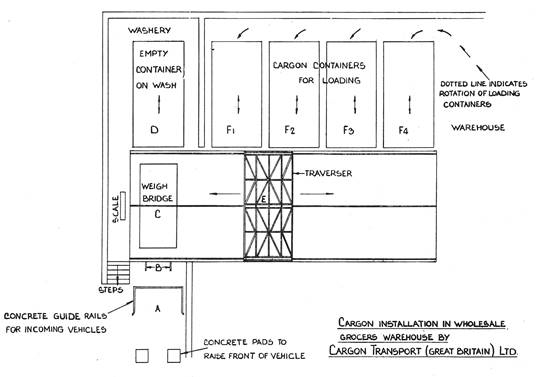
Note: the complete turn-round time from arriving with an empty container to driving away with a new load is approximately five minutes.
Economies achieved by installing the freighting system
After two months working of the system, Mr Douglas Wright, a Director of G Wright and Son said "We are already saving a third of our handling costs". This saving is made possible by:
containers loaded in normal working hours - not on overtime;
double handling eliminated;
weighing makes possible a bonus for drivers;
four vehicles doing the work of six;
the space used for the complete installation is 600 sq ft less than that used for pre-assembling of orders under the old system.
APPENDIX VII
ADDRESS GIVEN AT DOUGGIE'S MEMORIAL SERVICE ON 8 DECEMBER 2001
St Gregory's Church, Marnhull
Douglas Norman Wright, known always to almost everyone except his mother as Douggie, was born on 29th May 1916. He died on 26th November 2001, aged 85.
Not many people know this, but my father was a martyr. He was a martyr to his feet; he
was a martyr to his teeth.......
But I jump ahead of myself. Douggie was born in 1916, the second son of Robert Smith Wright and Elsie Gertrude, nee Ireland.
After school at Weymouth Grammar, Douggie joined the family firm (G Wright and Son, provision merchants) as a trainee cheesemaker and was sent for a period to Southampton to complete his apprenticeship. He then joined the firm in Dorchester where, on the death of his father in 1936, he became Chairman and Managing Director. His elder brother Robin later left Lloyds Bank in Wimborne where he had been working to join the company as a Director and Company Secretary.
At the beginning of the war, despite his chronic flat feet and his eye problems, Douggie managed to wangle his way into the Royal Artillery, where in due course he reached the rank of Major. Towards the end of 1941, his battalion was ordered to embark for Singapore. There wasn't room for all of them on the allocated ship and Douggie, because his surname began with "W", was allocated to a second ship leaving some time after the first. The first ship arrived in Singapore in February 1942, where it sailed straight into the Japanese invasion and fell immediately into enemy hands. Douggie's battery was stopped on its way down to Singapore and sent back to Gibraltar, where he remained for some time. On one occasion, he was assigned to deliver some papers to the British HQ in Algiers. On arrival at the quay, he was met by a driver and car. Douggie decided he wanted to stretch his legs, and told the driver to meet him at the dock gates. As the driver drove off, a car bomb that had earlier been attached to the vehicle exploded, writing off the car entirely and killing the driver outright. Douggie was completely unscathed.
Eventually, he got bored firing heavy shells across the straights into North Africa and he successfully applied for a transfer to the infantry, where he ended the war assigned to intelligence duties with the Dorset Regiment in Berlin.
In the course of the war, he had met and courted Nora Hatton-Jones, a very attractive young member of the First Aid Nursing Yeomanry (yes, kids, your grandmother was a "Fanny") who was working as a morse code operator sending and receiving signals between bases in the UK and our agents working in Northern Europe. In 1944, they were married. And following the end of the war, they moved together to Dorchester where Douggie rejoined the family firm. Christopher, their first son, was born in 1946 and sadly died very shortly after birth. Caroline was born in 1947. And I was born in 1951. In the same year, Douggie became the inaugural chairman of the Dorchester Round Table (probably to get away from the noise at home); he was delighted to be able to attend as a guest the Table's Golden Jubilee Dinner earlier this year, celebrating their 50 years of existence.
Throughout the '50s and '60s, Douggie and Robin continued to grow the family firm, broadening out into new products and new ventures as they went. They expanded from wholesale grocery into cash and carrys and into supermarkets and in the late 1960s merged with a firm on the Isle of Wight and took the company to a quotation on the London Stock Exchange under the name Upward and Rich. This - the turning of a dozy little rural provision merchants into a significant, publicly quoted, regional business - was a very significant achievement. That said, I remember Douggie's disappointment when the company was trying to keep the shelves stocked in their supermarkets during the first Isle of Wight pop festival in the late '60s: "they won't eat anything except ruddy yoghurt," he complained!
Also in the 1960s, Douggie set up a very small business within the Wright group of companies called Wright Pugson which later, when he gave up his interest in Upward and Rich, became his sole interest. This company existed to make stainless steel machinery for the food trade, particularly for preparing and curing bacon and for cutting, preparing and wrapping different kinds of cheese. This was something very close to Douggie's heart: he'd always really wanted to be an engineer and Wright Pugson gave him a hobby firm within the company in which he could indulge his passion for designing Heath Robinson-like machines for doing odd and exotic things to cheeses and other food. His proudest moment was when he worked out - in his sleep apparently - how to mechanise the shelling of hard boiled eggs; and I will always think of him, following his inspiration in developing a machine for injecting bacteria into soft cheeses, as "the man who put the mould in Lymeswold" (which was always sold by the Milk Marketing Board far too young and therefore lost out to very similar European cheeses like Cambozola and blue brie).
In 1954, Douggie and Nora had moved to Louds Piece in Dorchester, the house in which we were to grow up and which was always home not only to us but also to a string of more or less exotic animals and always humming with people. They changed the house constantly; and built a tennis court and swimming pool which always attracted lots of friends and relatives in the warm summers we used to have in those days. One of Douggie's abiding recreations was to vacuum the leaves from the bottom of the pool - a job that seemed always to take hours but served very effectively to get him out of more mundane things around the house.
It was in 1969 at Louds Piece that Douggie and Nora decided that they had to all intents and purposes to adopt Caroline's child Penny/Pebble and bring her up as their own child. This was a momentous decision for them. They had at that stage seen their own family grow up and move on. I, the youngest, was already away at university. Douggie, at the advanced age of 53, found himself thrust back into the role of becoming a father to his two-and-a-half year old granddaughter. And things were very much more complicated when, in 1974 at the very young age of 49, Nora unexpectedly died.
For a while, things looked very bleak indeed. But then, as I think everyone here will recognise - and as Douggie himself I know felt unquestioningly - his luck turned again. In September 1974, he married Hazel Southcombe in Weymouth. For the next 27 years, despite all the problems we could throw at them as a family (and it's true to say we between us tried almost everything, I think, except drugs), they remained absolutely devoted to each other, bringing up Pebble as their own. I know that it gave Douggie immense pleasure (in the nicest possible sense) that five years ago he was able to give Pebble away again - this time in marriage here in St Gregory's.
In 1988, at the tender age of 72, Douggie decided to retire from Wright Pugson and he sold the company. And in 1990, they decided to leave Dorchester and to move up here to Marnhull - a move which took them nearer to Hazel's family but not quite out of the county of Dorset - a move which neither of them have at any time had any moment to regret. But though he had retired, Douggie wouldn't stop working. He quickly mastered his computer, and then he flung himself into village life, becoming very quickly (as many people and organisations represented here today will affirm) an important contributor to the life of the community with his printing of posters, booklets, leaflets, agendas, meeting notices and so on for so many local charities, his direct support for specific charities such as the Macmillan Nurses, getting actively involved in Probus (including acting as speaker finder for more years than I think he ever really intended) and enjoying his sociable dabbling in shares through the Shottsford investment/dining/drinking club. His involvement in the church, too, grew -fostered by his reading of the lessons at Margaret Marsh and by his friendship with Norman Barnett.
I'm sure it's true to say that Douggie loved his retirement. He'd always been worried about giving up work; he'd often said to me that he thought that we should retire between the ages of 18 and 25 when we were young enough to enjoy it - and I have to say now how grateful I am that he allowed me the opportunity to go to university so that I could do exactly that - and then we should work until we dropped dead. But, in the event, he loved his retirement because it gave him time to work not just to earn a living but rather to work for other people, to make new friendships, and particularly to extend help to people to whom he could offer his talents and time. I think he surprised even himself that he could be so busy not "working" - and so happy in the process! He loved, too, the holidays that he and Hazel were able to enjoy together, the people that they met and the places that they went. It was good for both of them that they had so recently been able to enjoy a short cruise in the Mediterranean. But if getting away was good, there was always a sense in which getting back was better.
So how will we remember him? We will, I know, remember his beetling, Chaplinesque walk. We will remember his barbeques. We will remember the one bad example he set his grandchildren: that he refused ever to eat anything green. We will remember the wines he so enjoyed both for drinking himself and for offering to others: he was a strong believer in the dictum that a glass of wine a day is good for you - and so a bottle a day must be six times as good. We will remember his fondness for gadgets. We will remember his strong sense of family, which extended not only to me and Pebble and our respective spouses (Janey and Hugh) and to his grandchildren and to his great-granddaughter; but also to his brother Robin and to Lois and to their children, Mary and Liz; and to Hazel's extended family, too. We will I'm sure, above all, remember his sense of humour: nothing was ever so serious that he couldn't find a funny side to it somewhere. He wasn't a big man - either physically or in terms of his commanding attention in a room full of people. But he was brilliant one-to-one: when he talked to people, he was always genuinely interested in what they had to say, in what concerned them. He made them the centre of his attention and thus became the focus of theirs. I never heard him knowingly hurt anyone or make an unfair or uncharitable comment. He was unfailingly polite. He was, as someone wrote in one of the many letters Hazel has received this week, "a man who attracted friendship". Despite the fact that he was not well quite often over the last few years - and despite the fact that his eyes had caused him disappointments and frustration on a daily basis throughout the whole of his life - he never complained. He set demanding standards - both for others and for himself-standards which sometimes some of us failed to live up to, which meant that life in the family was not always easy. But he never bore a grudge and he could quickly put things behind him and move on once a lesson had been delivered. He was always very tidy and punctilious: I can't help but feel it was somehow prescient on his part that he got his hair cut on the day he died. He was also an impatient man: it is equally typical that he died, when the moment came, without hanging around.
More than anything, though, in the village and amongst his friends, people will remember his generosity. His generosity of spirit - both metaphorical and percent proof. His generosity of time. His generosity of money. His willingness always to put himself out for people who were less fortunate, in whatever way, than he was. He was unstinting, despite in later years the personal effort involved on his part. And in the family, we will remember I am sure the fact that he loved us all completely unquestioningly - Hazel in particular, to whom he gave and from whom he received so much over the last 27 years.
He was, from beginning to end, a Dorset man. He liked to tell the story of the Piddle valley taxi driver who, on being asked one day if he'd lived all his life in Dorset, replied "not yet". For Douggie, the telling of that story was a reminder that he too had not lived all his life in Dorset - "not yet". But he has now. And he is I am sure very proud of the fact - just as Dorset should be very proud of him.
As Hannah's reading says: "parting is hell". But when we go from here, I hope as many as can manage it will join us in the Methodist Church Hall. There we will drink bucks fizz. And we shall talk. And we shall laugh. And we shall be, above all, convivial. Because, you know, he would not have had it any other way. God bless him.